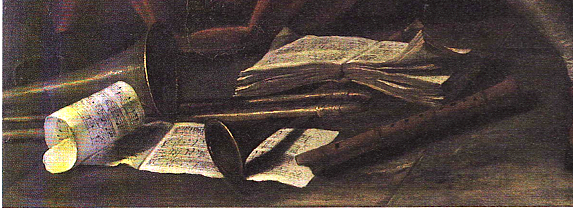A history of the alto trombone in timeline form. For sources see Alto Trombone History Bibliography.
A note on sources: In historical research, primary sources are gold. Why? Because they bring readers closer to actual documented facts rather than individual interpretations and opinions. The timeline below draws from more than 100 primary sources, which is, chances are, more primary sources than any other single document on the alto trombone (with the possible exception of bibliographies). In addition, the timeline utilizes numerous current secondary sources, including Early Music, Historic Brass Society Journal, Galpin Society Journal, and a number of recently-published books. If you notice a source in the timeline that you feel has been somehow discredited or improperly vetted, by all means, let me know, and I will consider correcting or deleting the related entry.
_______________
c. 1400—The earliest trombones, according to some scholars, appear in northern Italy and southern France (Eliason). According to other scholars, it is more likely, based on performer nationalities and manufacturing locations, that the trombone originates in Germany (Herbert, Susato 117; Polk, Archival Documents).
1400-1420—According to Polk, “The trombone, though not yet universal, [becomes] an accepted fact of the musical scene in the first few decades of the fifteenth century” (Polk, German 66).
1494-97—Italy: Benedetto da Maiano’s high relief marble sculpture, The Coronation of Alfonso II, features what are probably 3 trombone players. Although the sculpture is badly damaged, a full trombone is visible in the hands of one of the brass players, and the embouchure and grip of another player are clearly visible. Noteworthy aspects of the rendering include the non-underhand left-hand grip of the 2 players, the relatively small size of the trombone (cf. Bellini detail—1496, below), and the banners apparently attached to the slides (cf. Aldegrever—1538 and Anonymous Nuremberg—c. 1550, 16th century) (see 2 details and wider view below; public domain) (Carl, Benedetto da Maiano 1:359). The sculpture is now held in Florence’s Museo Nazionale Bargello.

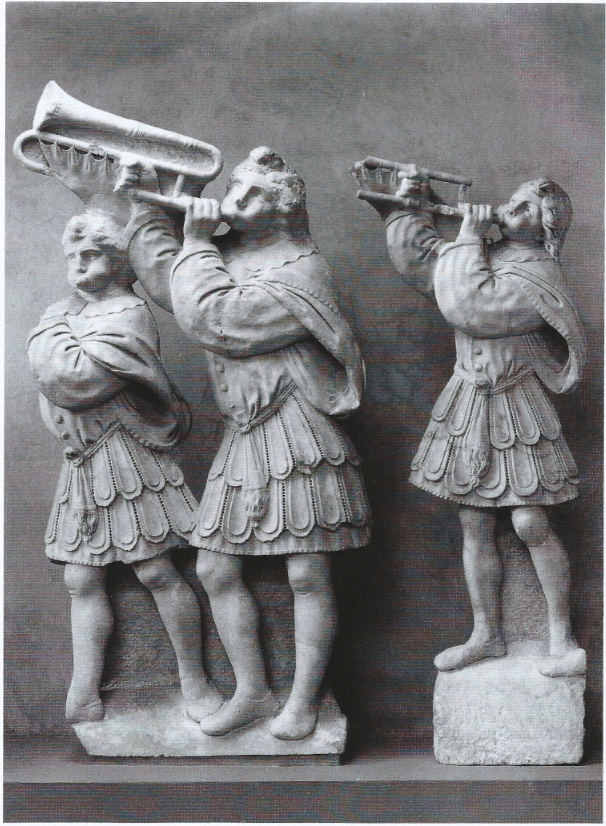
1496—Venice, Italy: Gentile Bellini’s Procession in Piazza San Marco (Venice, Accademia) depicts a wind band with an instrument that appears to be an alto trombone; notice, in particular, the size of the trombone relative to the player’s body (see below detail; public domain). Given the early date, the image may simply represent an artist’s attempt at a trombone rather than a specific depiction of an alto trombone.
16th century—Poland: A sixteenth-century inventory includes “one large quart sackbut” and “Three small sackbuts” (Przybyszewska-Jarminska, Baroque part I, 65).
16th century—Toledo, Spain: A fresco located in the courtyard called “de la Mona” at the Convent of las Comendadoras del Apóstol Santiago features numerous angel musicians, including an angel playing an instrument diminutive enough in proportion to its player to be an alto trombone or smaller (see detail and full image below; public domain).

 1541—Duke Albrecht of Prussia, who evidently employs trombonists, has an interesting exchange with prominent brass instrument maker George Neuschel of Nuremberg. The Duke orders, among other supplies, “4 tenor trombone mouthpieces” and “1 crook of a fourth for the quart-trombone.” Neuschel, in turn, attempts to sell Duke Albrecht numerous additional instruments and parts, including “1 silver trombone with a crook of a fourth, for use with voices and instruments” and “5 trombones, which are tuned together and from which a tenor trombone may be made into a bass or an alto” (Downey, From the Rim 8).
1541—Duke Albrecht of Prussia, who evidently employs trombonists, has an interesting exchange with prominent brass instrument maker George Neuschel of Nuremberg. The Duke orders, among other supplies, “4 tenor trombone mouthpieces” and “1 crook of a fourth for the quart-trombone.” Neuschel, in turn, attempts to sell Duke Albrecht numerous additional instruments and parts, including “1 silver trombone with a crook of a fourth, for use with voices and instruments” and “5 trombones, which are tuned together and from which a tenor trombone may be made into a bass or an alto” (Downey, From the Rim 8).
c. 1550—Netherlands: Artist Martin van Heemskerck includes a trombone-playing muse in his panel painting, Apollo and the Muses (see black and white detail and full image below; public domain; wikimedia commons) (New Orleans Museum of Art). This instrument appears to be relaitvely small and is perhaps an alto trombone. Look at the length of the trombone, for example, relative to the size of the heads nearby, or relative to the hand holding it. Notice, also, that the instrument appears to be supported easily with one hand. Colin Slim proposes the date 1546, by the way, in his article, “On Parnassus with Maarten van Heemskerck,” part II (Musica Disciplina, 1997).
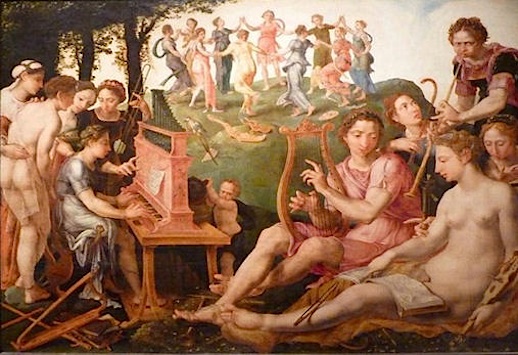
1564—Sevilla, Spain: At the Seville Cathedral, a bronze medallion by Juan Marin and Bautista Vazquez portrays 2 trombones performing with a cornett and 2 shawms. Based on the size of the trombone in front relative to the player, the instrument may be an alto trombone (see below image; public domain; click for larger version) (Kreitner, Minstrels in Spanish Churches).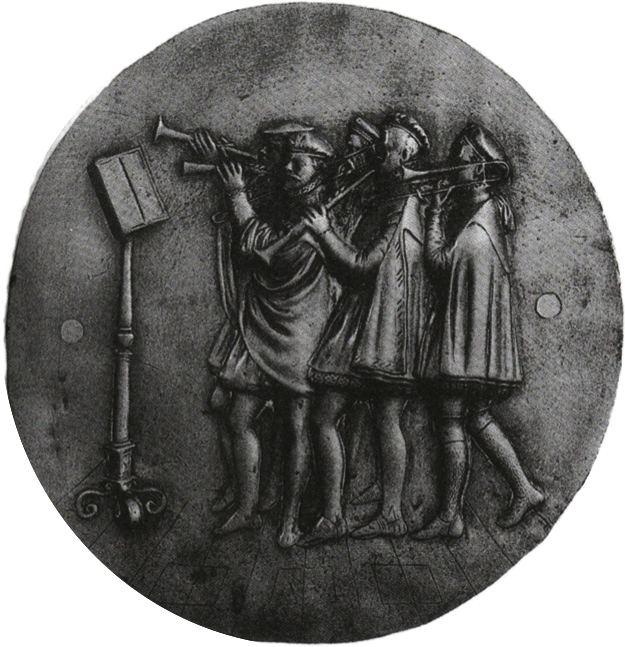
1565—The Low Countries: Musica, an engraving by Dutch artist Cornelis Cort from a series called the Seven Liberal Arts (after works by Frans Floris) includes a small trombone hanging on a wall in the background. It is nearly impossible to tell, as artists are often less than literal, but the instrument could be an alto trombone. Compare it proportionally, for example, with the other instruments nearby (see detail and full image below—click full image to expand; public domain) (Burgers 99).

1566—Giorgio Vasari’s image of a muse holding an instrument features what both Edmund Bowles and David Guion label an alto trombone. The image is associated with a performance of The Genealogy of the Gods for the wedding festivities of Prince Francesco de’ Medici and Johanna of Austria (see below image; public domain) (Bowles, Musical Ensembles 55; Guion, A History 127). Stewart Carter, apparently reluctant to call it an alto trombone, says the following: “The trombone in this illustration—very small, with an oddly truncated bell—may have been a theatrical prop, not a real instrument” (Carter, The Trombone in the Renaissance). However, research has shown that 1) “very small” trombones existed within only a few years of this date (see, for example, 1594 and 1597, below, from Carter’s own book), 2) additional iconography from the time period also depicts relatively small trombones (see 1496, 1564, 1595, etc.), and 3) another depiction of a trombonist by the same artist, Giorgio Vasari, is also relatively awkward, but, counter to Carter’s logic, the instrument is clearly not a prop (the man is actually playing the instrument in an ensemble); see this blog post to view the painting.
1573—Kassel, Germany: An inventory for the Hofkapelle lists “1 Quart Pusaun with its crooks [Bogen] and mouthpieces,” “2 Second Posaun with their appurtenances; the crooks of one are wanting, so that Hans Heugel has delivered one which he has used before and lengthened,” and “3 small Pusaun with their appurtenances; one less its crooks” (Baines, Two Cassel Inventories).
1593—Verona, Italy: Upon the death of Count Mario Bevilacqua, the count leaves a collection of instruments that includes “Due tromboni, un grande, et uno piccolo” (Castellani, Veronese Inventory).
1593—Arnstadt, Germany: A letter from Count Anton Heinrich of Sondershausen to Christian Kirchberger, treasurer of the Arnstadt town council, lists instruments the Count wants purchased in Leipzig for his Hofkapelle. Included is a request for Einfache Posaunen (ordinary trombones), implying, of course, various sizes of trombones (Boydell, Crumhorn 66).
1593—Dresden, Germany: An inventory of instruments in the court’s Instrumentenkammer includes trombones of several different sizes (Oleskiewicz 162).
1594—Prague, Czech Republic, and Kassel, Germany: Alessandro Orologio, a composer and instrumentalist at the court of Rudolf II in Prague, visits the court of Moritz von Hessen in Kassel, Germany. After the visit, he recommends, through a letter, that the Kassel court purchase a large number of instruments. Included among the recommended instruments are the following trombones: “In Nuremberg, two Tromboni piccolo and one grosso…and two even smaller [piu piccolo] that serve as sopranos.” As Stewart Carter points out, the two “even smaller” trombones are probably alto trombones (Carter, The Trombone in the Renaissance 316-17).
1595—Antwerp, Belgium: Philippe Galle’s copperplate engraving, after a work by Johannes Stradanus (Jan van der Straat), features trombone performing in a sacred setting, during the celebration of a Mass. One trombone is pictured in the immediate foreground, while another, possibly an alto trombone, is shown very near the music desk. The text at the bottom of the engraving reads, “The people refine the heavenly worship with melodious arts and adorn the sacred rites with song. The horns fill the holiest portion of the temple with many sweet tones; the fistula [reed pipe] plays harmoniously with the Etruscan trumpet, and discord delights the souls, and the Muse lifts the earthly minds to the heavens” (see below detail; public domain) (Salmen, Musikleben im 16 183; Naylor 10).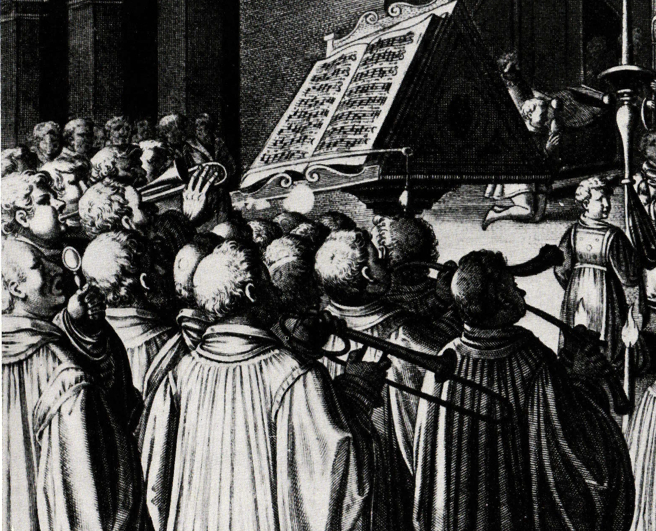
1597—Barcelona, Spain: An inventory prepared for an auction features various sizes of trombones, including a sacabuche tiple pequeño, which is “probably an alto trombone,” according to Stewart Carter (Carter, The Trombone in the Renaissance 343-44).
1607—Mantua, Italy: Monteverdi’s L’Orfeo, considered by many the first true opera, uses 5 trombones (2 altos, 2 tenors, and a bass). Trombones are particularly prominent in the underworld scenes (Daubeny 95). An ensemble of trombones and cornettos plays in acts III and IV.
1613—Kassel, Germany: An inventory of the Hofkapelle includes several sizes of trombones, along with various parts of these instruments: “1 great posaune with its E…[?] or joints [gliedern] mounted with silver, partly gilded; with slides [zugen] and crooks [bogen]; also 2 silver mouthpieces and a silver image [biltlein],” “1 bad posaune with its slide and crooks,” “4 Tenor and Alt posaunen, with 7 crooks and shanks,” “2 small Alt or Discant posaune with 3 crooks and shanks,” “1 Quart posaune with crooks and slide,” and “1 bell [glocke] of a posaune without appurtenances and front section” (Baines, Two Cassel Inventories).
1618—An anonymous oil painting depicts a wedding procession led by 4 town musicians—alto, tenor, and bass trombones with cornett (instrument identification according to Walter Salmen). The wedding party is apparently wealthy and the musicians are elegantly dressed. The painting is set against the backdrop of the Hanseatic town of Bremen (Salmen, Status).
 1619—Wolfenbüttel, Germany: In the third volume of his treatise, Syntagma Musicum, Michael Praetorius discusses use of alto trombone in several different settings. The first is in the context of the cornett and violin choir: “But if another C-3 clef is used besides the one for the basset and other clefs noted above, it is better to use a sackbut together with the cornetts (if an alto sackbut player who plays really well is available), and a Viol da bratio…” (Praetorius III Kite-Powell 159). Later he mentions alto trombone in the context of choirs of trombones and curtals, naming it as a possible instrument for the top voice of an ensemble “with six sackbuts, curtals, or shawms” (Praetorius III Kite-Powell 165), in addition to stating, “Not everyone playing in the alto clef on the ordinary tenor sackbut can reach g’ and a’ lamire and even fewer on a chorist [double] curtal. If the first part is intended to be played a fourth or fifth lower as an alto, that part must be played either on an alto sackbut or treble [single] curtal…or sung by an alto” (Praetorius III Kite-Powell 167). He also points out that alto trombone is referred to as trombone picciolo in Italian (Praetorius III Kite-Powell 132).
1619—Wolfenbüttel, Germany: In the third volume of his treatise, Syntagma Musicum, Michael Praetorius discusses use of alto trombone in several different settings. The first is in the context of the cornett and violin choir: “But if another C-3 clef is used besides the one for the basset and other clefs noted above, it is better to use a sackbut together with the cornetts (if an alto sackbut player who plays really well is available), and a Viol da bratio…” (Praetorius III Kite-Powell 159). Later he mentions alto trombone in the context of choirs of trombones and curtals, naming it as a possible instrument for the top voice of an ensemble “with six sackbuts, curtals, or shawms” (Praetorius III Kite-Powell 165), in addition to stating, “Not everyone playing in the alto clef on the ordinary tenor sackbut can reach g’ and a’ lamire and even fewer on a chorist [double] curtal. If the first part is intended to be played a fourth or fifth lower as an alto, that part must be played either on an alto sackbut or treble [single] curtal…or sung by an alto” (Praetorius III Kite-Powell 167). He also points out that alto trombone is referred to as trombone picciolo in Italian (Praetorius III Kite-Powell 132).
1620—Germany: Woodcuts of the various members of the trombone family appear in Michael Praetorius’s Sciagraphia, a collection of illustrations appended to Syntagma musicum. The trombones pictured include alt or discant posaun (comparable to modern alto), gemeine posaun (comparable to modern tenor), quart- or quint-posaun (bass trombones, fourth and fifth below tenor), and octav posaun (contrabass, an octave below tenor). See below image (Praetorius II, plate 8; public domain image).
 1629—Dresden, Germany: Philipp Hainhofer, a visitor from Augsburg, visits the “pipe and instrument chamber” at the Dresden palace (where Heinrich Schütz is Kapellmeister). The chamber includes, among other instruments, “An octave trombone, which they consider a rarity; a quint-terce-tenor trombone; some small discant trombones” (Moser 138). The “discant trombones” mentioned could be alto trombones; 9 years earlier, Praetorius, another German, refers to alto trombone as “discant” trombone (see 1620, above). In addition, Hainhofer describes a specific court player of what is probably an alto trombone: “There were also Elias Püncker, harpist, and Ernst Trost. The latter embellishes on the little trombone whatever he hears played for him on cornets and fiddles” (Moser 139).
1629—Dresden, Germany: Philipp Hainhofer, a visitor from Augsburg, visits the “pipe and instrument chamber” at the Dresden palace (where Heinrich Schütz is Kapellmeister). The chamber includes, among other instruments, “An octave trombone, which they consider a rarity; a quint-terce-tenor trombone; some small discant trombones” (Moser 138). The “discant trombones” mentioned could be alto trombones; 9 years earlier, Praetorius, another German, refers to alto trombone as “discant” trombone (see 1620, above). In addition, Hainhofer describes a specific court player of what is probably an alto trombone: “There were also Elias Püncker, harpist, and Ernst Trost. The latter embellishes on the little trombone whatever he hears played for him on cornets and fiddles” (Moser 139).
1636—Assissi, Italy: Giovanni Battista Buonamente’s Sonata a 5 and Sonata a 6 specify “trombone contralto; trombone tenor; trombone basso” (Allsop 148). Amintore Galli, professor at the Milan Conservatory, later describes “trombone contralto” as an E-flat instrument (see 1898, below).
c. 1640—Poland: Marcin Mielczewski’s Missa Cerviensiana calls for alto trombone, 2 tenor trombones, and bass trombone (Przybyszewska-Jarminska, Baroque part I, 543).
c. 1640—Poland: Marcin Mielczewski’s Missa Sancta Anna calls for alto trombone and 2 tenor trombones (Przybyszewska-Jarminska, Baroque part I, 543).
c. 1640—Poland: Marcin Mielczewski’s Missa triumphalis calls for alto trombone, 2 tenor trombones, and bass trombone (Przybyszewska-Jarminska, Baroque part I, 543).
c. 1640—Poland: Marcin Mielczewski’s Vesperae Dominicales II calls for alto trombone as a substitute for alto voice, tenor trombone as a substitute for tenor voice, and bass trombone as a substitute for bass voice in 2 of 4 choirs (Przybyszewska-Jarminska, Baroque part I, 544).
 1642—Hamburg, Germany: Kantor Thomas Selle, in his guidelines for instrumentalists, recommends that each of the 5 performers (minimum) be proficient on a number of instruments: 2 cornettists should also bring violins and recorders, an alto trombonist should also play violin and recorder, another trombonist should be capable of playing tenor trombone, bass trombone, tenor violin, and recorder, and a string bass player should also play bassoon, dulcian, and bass trombone (Buelow, Protestant 192).
1642—Hamburg, Germany: Kantor Thomas Selle, in his guidelines for instrumentalists, recommends that each of the 5 performers (minimum) be proficient on a number of instruments: 2 cornettists should also bring violins and recorders, an alto trombonist should also play violin and recorder, another trombonist should be capable of playing tenor trombone, bass trombone, tenor violin, and recorder, and a string bass player should also play bassoon, dulcian, and bass trombone (Buelow, Protestant 192).
1647—Vienna, Austria: In his motet, Cantate gentes, Giovanni Valentini calls for 7-part choir, along with an instrumental ensemble of 3 cornetti, violetta, viola, 2 trombones, and organ. The ensemble plays an introductory sonata and interludes between the 4 verses of the motet. Valentini indicates optional substitutions for 3 of the parts: “Piffaro o Cornetto tertio,” “Alto Trombone o Violetta primo,” and “Viola o Trombone secondo” (Saunders, The Hapsburg Court of Ferdinand II).
1648—Leipzig, Germany: Stephan Otto publishes his vocal collection Kronen Krönlein. Several pieces in the collection specify trombones, including Sihe meine Freundin and O ihr lieben Hirten, both of which call for “trombone picciolo” and 2 trombones (Collver 142). Less than 30 years earlier, Praetorius had stated the following about trombone terminology used by Italians: “The word trombone is usually used for the tenor sackbut; bass sackbut, however, is called trombone majore and alto sackbut is trombone picciolo…” (Praetorius III Kite-Powell 132). And in the illustrations of his Sciagraphia of 1620, Praetorius clearly shows the alto trombone as a shorter instrument than the tenor trombone (Praetorius II, plate 8).
1649-1701—Nuremberg, Germany: Wolff Birckholtz manufactures what is possibly the earliest extant alto trombone. The instrument is held in Marienkirche, Gdansk (Herbert, Trombone 313).
c. 1650—Netherlands: Cesar van Everdingen includes what appears to be a trombone among several instruments at the bottom of the image in his painting, Four Muses and Pegasus on Parnassus. Although it is impossible determine with certainty, the instrument may be an alto trombone, given its size relative to the surrounding instruments (see below image; public domain) (Huis ten Bosch, The Hague).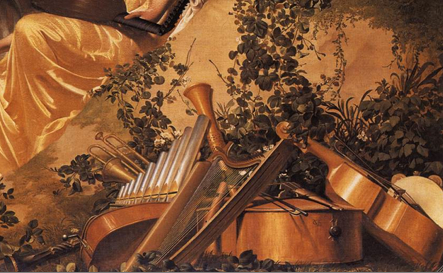
c. 1650—Instrumentälischer Bettlermantl (“An Instrumental Patchwork”), an anonymous musical compendium written in German and Latin, offers illustrations of 4 sizes of trombones with their respective slide positions (Campbell, Instrumentälischer).
c. 1650—Poland: Bartlomiej Pekiel’s Missa Concertata La Lombardesca calls for an instrumental accompaniment of 2 violins and 3 trombones (labeled alto, tenore, and grosso) (Przybyszewska-Jarminska, Baroque part I, 261).
c. 1650—Padre Giambattista d’Este, gia duca Alfonso III, a painting by Matteo Loves, includes what is probably a trombone (bottom-right of full image) among a number of other musical instruments. Judging by the size of the objects around it (lute, violin, music book, text book), the instrument appears to be of alto trombone size. There is some extra tubing on the back bow of the instrument (see detail and full image below; public domain) (Galleria Estense, Modena).
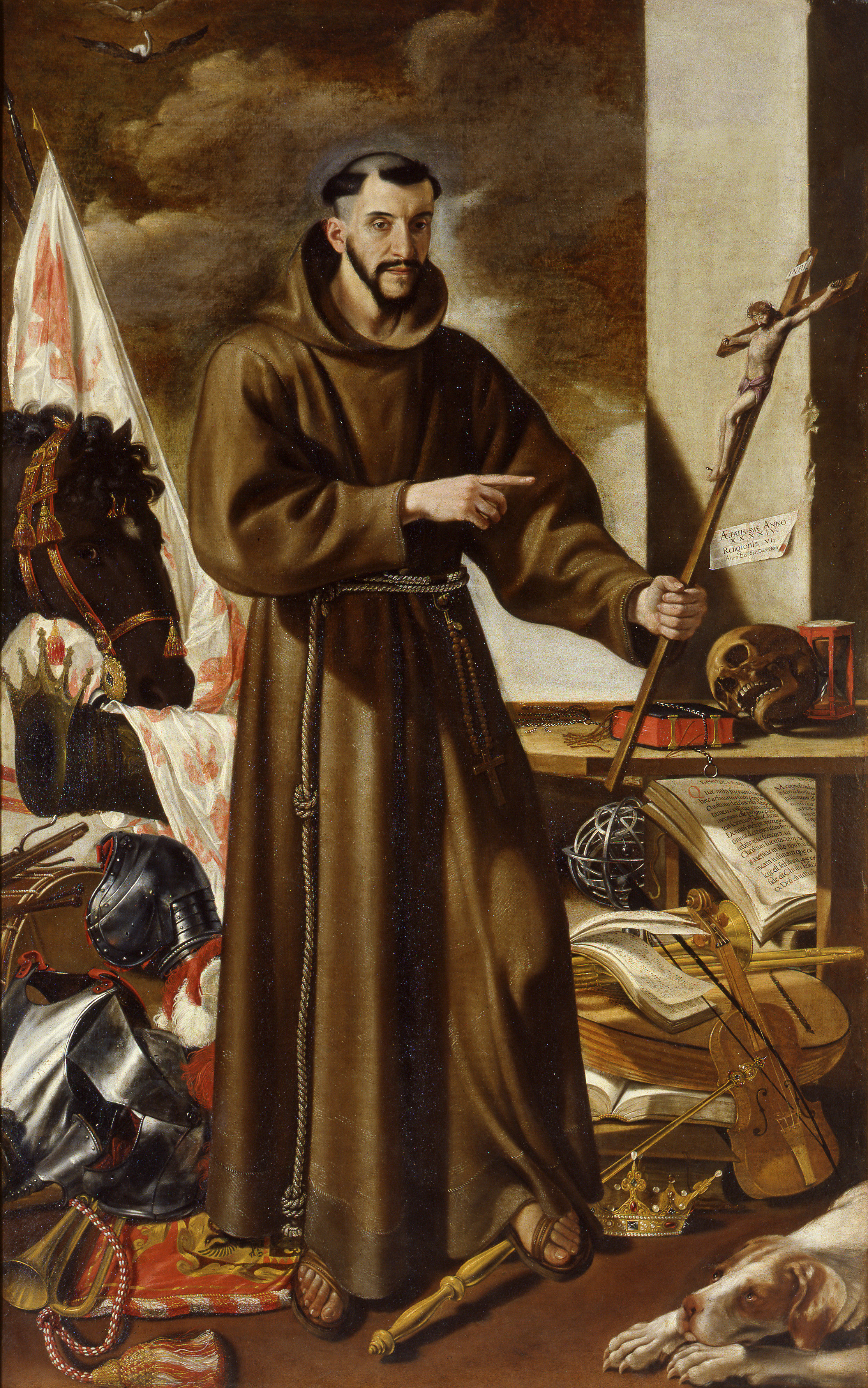
c. 1650—Italy: Swiss-born artist Pier Francesco Mola includes a trombone in his painting, Young Musician Playing a Viola da Gamba. Although it is impossible determine with certainty, the instrument may be an alto trombone, given its size relative to the surrounding instruments and music pages (see detail and full image below; public domain) (Mola 161).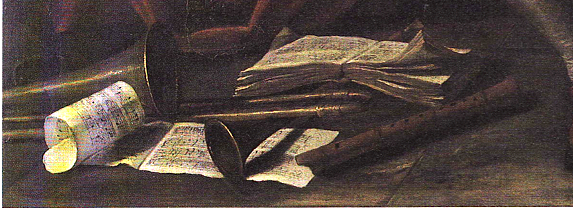

1652—Nuremberg, Germany: Sebastian Hainlein II manufactures one of the earliest extant alto trombones. The instrument is held in Marienkirche, Gdansk (Herbert, Trombone 313).
1658—Görlitz, Germany: Georg Ball und seine Stadtpfeifer, a painting by Johann Geisius, includes a trombone player sitting around a table with a group of musicians. The trombone is relatively small and could be an alto trombone (see detail and full image below; public domain). Special thanks to Tassos Dimitriadis.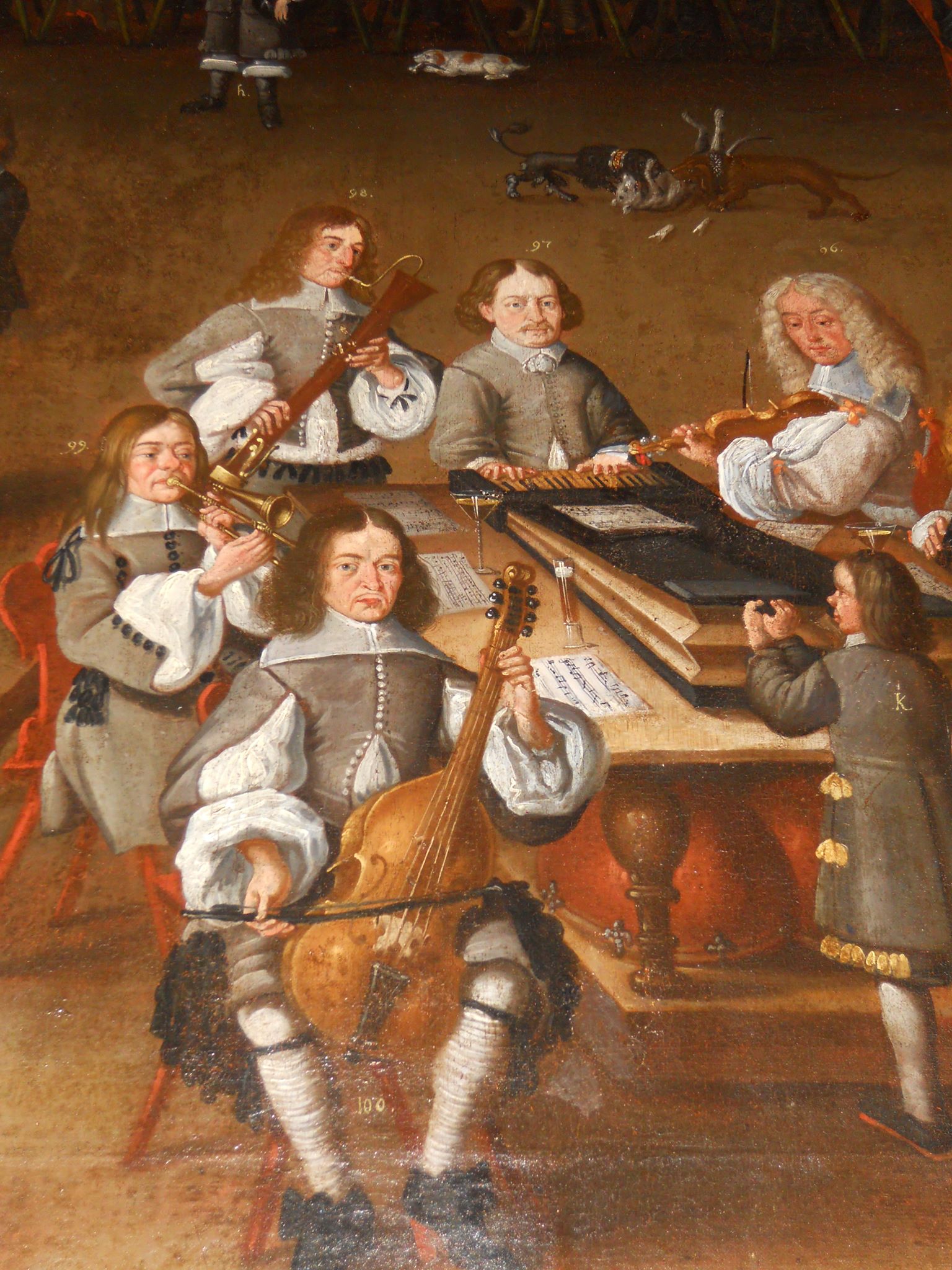
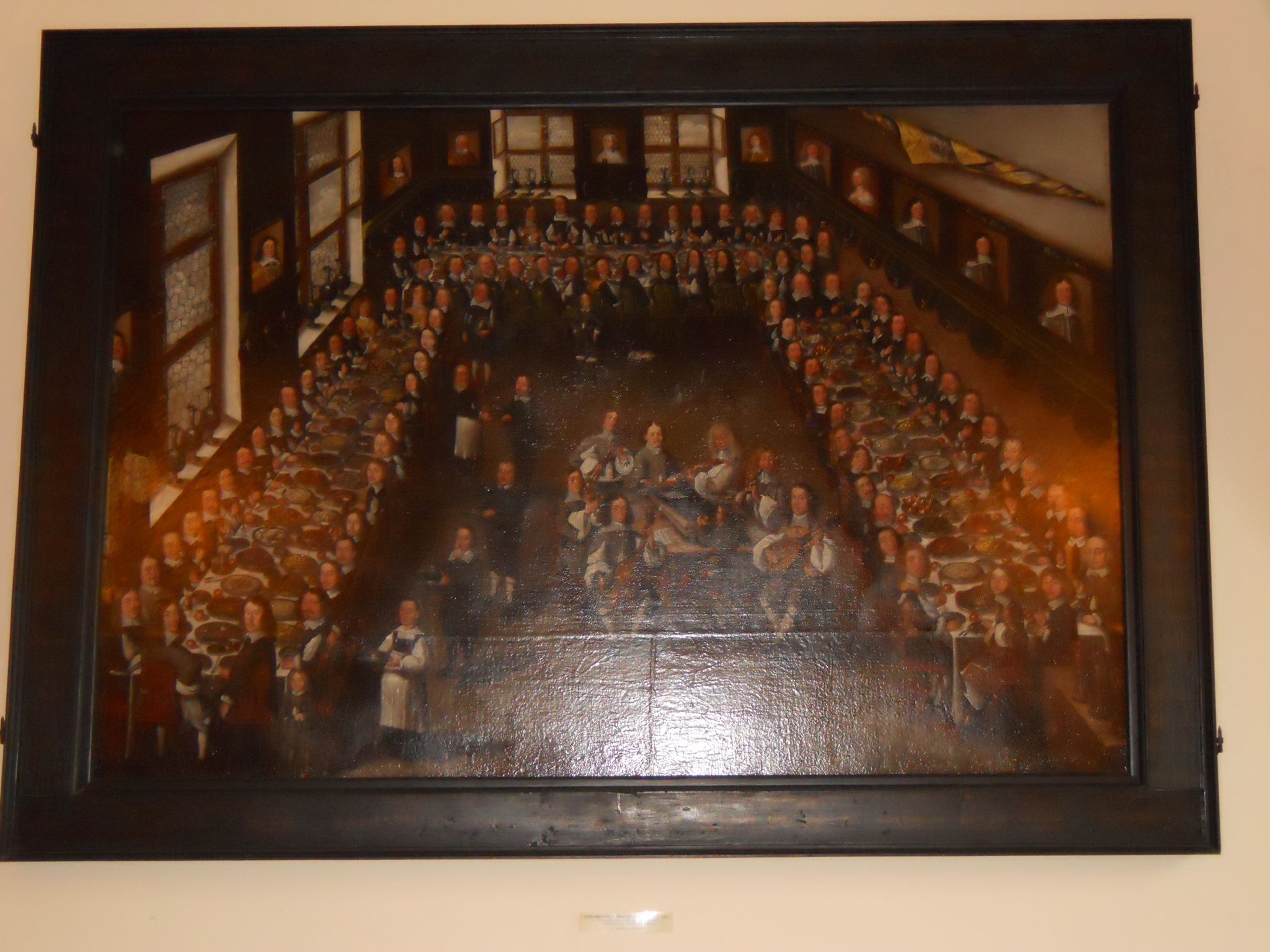
1663—Nuremberg, Germany: Manufacture date of an alto trombone by Michael Nagel of Nuremberg, one of the earliest extant models. Pitched in E-flat, it is labeled “Macht Michael Nagel, Nurnb., 1663” and features a detachable stay on the bell, with tubular stays on the slide (possibly added at a later date). Less ornate than many older trombones, the instrument may mark the beginning of a trend of Nuremberg manufacturers toward more utilitarian appearance of instruments. The instrument is held at Horniman Museum in London (Carse, Collection 68; Gregory 35, 52).
1667—Martin Schneider writes Erster Theil. The collection contains several works for the following instrumentation: soprano voice, alto trombone, tenor trombone, 2 trumpets (or cornettinos or violins), violone or trombone, and continuo (Collver 166).
1674—Lübeck, Germany: St. Mary’s, employer of the influential organist and composer Dieterich Buxtehude, purchases two diskant Posaunen. This name (diskant Posaune) had been given by Praetorius several decades earlier as a name for the alto trombone, which he clearly depicts as a smaller, shorter instrument (see 1620, above, for Praetorius) (Snyder, Buxtehude revised 379).
c. 1675—Poland: Stanislaw Sylwester Szarzynski’s Gloria in excelsis Deo calls for an instrumental accompaniment of 2 violins and 3 trombones (labeled Trombone Alto, Trombone Tenore, and Trombone Basso e Viola) (Przybyszewska-Jarminska, Baroque part I, 322).
1687—Cracow, Poland: An inventory of the musical instruments belonging to the Jesuit chapel lists 5 trombones, including one alto and one bass (Przybyszewska-Jarminska, Baroque part I, 156).
1694—Vienna, Austria: Antonio Draghi’s aria, “Si spezza il suolo” from Il libro con sette sigilli, features a trombone obbligato and is scored for bass voice, alto trombone, and bassoon (Carter, Trombone Obbligatos).
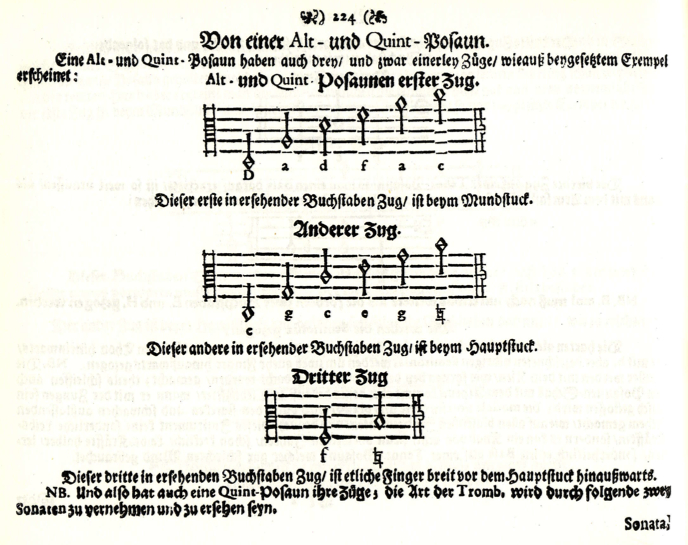
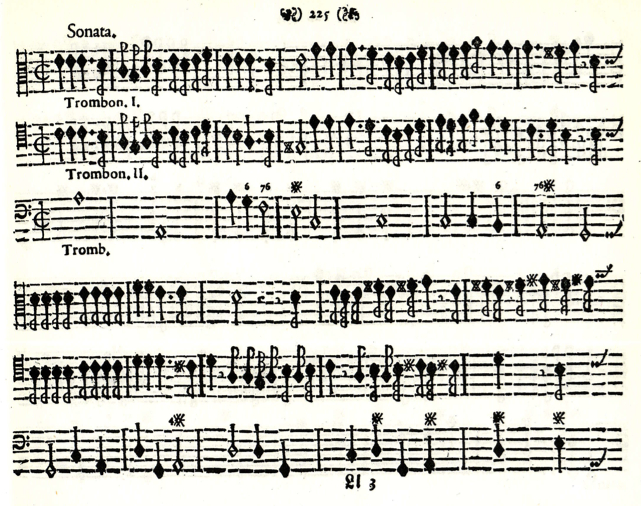 1697—Daniel Speer mentions alto trombone along with tenor and bass trombone in his treatise, Vierfaches Musikalisches Kleeblatt. His description and position charts show four diatonically-numbered positions for each member of the trombone family and indicate that, at this time, tenor trombone is probably pitched in A, alto in D, and bass in D (see facing image for Speer’s alto and bass diagrams; public domain). The author provides, along with his trombone description, two 3-part sonatas for trombones (see facing image for first page of first sonata; public domain) (Speer Vierfaches 179-83). In a separate section of the treatise, Speer discusses how to organize music performances in a small town, saying, “Since the middle voices (alto, tenor, and bass) are most commonly played on viols or trombones in the churches, the guild musicians suffer only the slightest disadvantage in their accustomed wages by the students playing these parts, though the guild musicians make many idle complaints” (Speer Vierfaches 204).
1697—Daniel Speer mentions alto trombone along with tenor and bass trombone in his treatise, Vierfaches Musikalisches Kleeblatt. His description and position charts show four diatonically-numbered positions for each member of the trombone family and indicate that, at this time, tenor trombone is probably pitched in A, alto in D, and bass in D (see facing image for Speer’s alto and bass diagrams; public domain). The author provides, along with his trombone description, two 3-part sonatas for trombones (see facing image for first page of first sonata; public domain) (Speer Vierfaches 179-83). In a separate section of the treatise, Speer discusses how to organize music performances in a small town, saying, “Since the middle voices (alto, tenor, and bass) are most commonly played on viols or trombones in the churches, the guild musicians suffer only the slightest disadvantage in their accustomed wages by the students playing these parts, though the guild musicians make many idle complaints” (Speer Vierfaches 204).
 1703—Paris, France: Sébastien de Brossard describes four different sizes of trombones under the “trombone” heading of his Dictionnaire de musique: “There are several sizes which are capable of serving in the performance of different parts in the music: There is a small one which the Italians call TROMBONE PICCOLO and the Germans KLEINE ALT-POSAUNE which can serve as the counter-tenor; the part for it is usually entitled TROMBONE PRIMO or 1o. There is another one, a little larger, which is called TROMBONE MAGGIORE or MAJORE which can serve as the tenor; its part is entitled TROMBONE SECONDO, IIo, or 2o. There is a third, even larger, which the Italians call TROMBONE GROSSO and the Germans GROSSE QUART-POSAUNE which can supplement our viola or oboe; its part is entitled TROMBONE TERZO, IIIo, or 3o. Finally, there is one which is the largest of all, one which the Italians call TROMBONE GRANDE and which is heard a great deal especially playing the bass; its part is entitled TROMBONE QUARTO, IVo, or simply TROMBONE without other addition. It is usually given the fourth-line F-clef, but also very often the fifth-line F-clef because of the depth and profundity of its notes” (paragraph breaks not shown) (Brossard-Gruber 196). The “trombone piccolo” or “kleine alt-posaune” that Brossard describes is an alto trombone.
1703—Paris, France: Sébastien de Brossard describes four different sizes of trombones under the “trombone” heading of his Dictionnaire de musique: “There are several sizes which are capable of serving in the performance of different parts in the music: There is a small one which the Italians call TROMBONE PICCOLO and the Germans KLEINE ALT-POSAUNE which can serve as the counter-tenor; the part for it is usually entitled TROMBONE PRIMO or 1o. There is another one, a little larger, which is called TROMBONE MAGGIORE or MAJORE which can serve as the tenor; its part is entitled TROMBONE SECONDO, IIo, or 2o. There is a third, even larger, which the Italians call TROMBONE GROSSO and the Germans GROSSE QUART-POSAUNE which can supplement our viola or oboe; its part is entitled TROMBONE TERZO, IIIo, or 3o. Finally, there is one which is the largest of all, one which the Italians call TROMBONE GRANDE and which is heard a great deal especially playing the bass; its part is entitled TROMBONE QUARTO, IVo, or simply TROMBONE without other addition. It is usually given the fourth-line F-clef, but also very often the fifth-line F-clef because of the depth and profundity of its notes” (paragraph breaks not shown) (Brossard-Gruber 196). The “trombone piccolo” or “kleine alt-posaune” that Brossard describes is an alto trombone.
 1704—Leipzig, Germany: Bach’s predecessor, Johann Kuhnau, complains to authorities that the church’s trombones are in a battered and useless condition. He requests a new “choir” of 4 trombones—discant, alto, tenor, and bass—but does not receive it (Terry 18).
1704—Leipzig, Germany: Bach’s predecessor, Johann Kuhnau, complains to authorities that the church’s trombones are in a battered and useless condition. He requests a new “choir” of 4 trombones—discant, alto, tenor, and bass—but does not receive it (Terry 18).
1705—Vienna, Austria: Marc’ Antonio Ziani writes the solo motet Alma Redemptoris Mater. Scored for 2 trombones, bassoon, alto voice, and continuo, it includes numerous solo passages for trombone. The top trombone part lends itself to alto trombone (Wigness 26).
1708—Vienna, Austria: Marc’ Antonio Ziani’s aria, “Se dei pur senz’ aita” from La passione nell’orto, features an obbligato alto trombone and is scored for alto voice and alto trombone (Carter, Trombone Obbligatos).
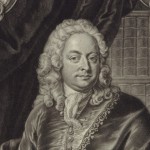 1713—Johann Mattheson writes, “The most magnificent-sounding trombone…is a type of trumpet, on which the notes are produced by pulling out and in, in conjunction with blowing. There are large and small trombones, namely: small alto, large alto, tenor or large quart, and bass trombone, which can form a full choir by themselves, but are used very rarely, except in church pieces and solemn music” (Guion, Trombone 25).
1713—Johann Mattheson writes, “The most magnificent-sounding trombone…is a type of trumpet, on which the notes are produced by pulling out and in, in conjunction with blowing. There are large and small trombones, namely: small alto, large alto, tenor or large quart, and bass trombone, which can form a full choir by themselves, but are used very rarely, except in church pieces and solemn music” (Guion, Trombone 25).
1713—Francesco Magini publishes a collection of sonatas titled Sonate di Francesco Magini per il Campidoglio 1713. It includes 7 different sonatas scored for 4 trombones (alto, 2 tenors, bass) and 2 cornetts (Collver 59).
1716—Vienna, Austria: Johann Joseph Fux’s aria, “Vedi che il Redentor” from Il fonte della salute, features soprano voice and obbligato alto trombone (Carter, Trombone Obbligatos).
1717—Vienna, Austria: Antonio Caldara’s aria, “Quell’amor” from Santa Ferma, features soprano voice and obbligato alto trombone (Carter, Trombone Obbligatos).
1718—Vienna, Austria: Johann Joseph Fux’s aria, “Dal limbo” from Cristo nell’orto, features obbligato alto trombone and is scored for alto voice, alto trombone, and 2 violins (Carter, Trombone Obbligatos).
1718—Vienna, Austria: Francesco Conti’s aria, “Mia compagna io la credea” from La colpa originale, features alto voice with alto trombone obbligato (Carter, Trombone Obbligatos).
1719—Vienna, Austria: Johann Joseph Fux’s aria, “Da Christo ch’é pio” from Gesu Cristo negato da Pietro, features alto voice with alto trombone obbligato (Carter, Trombone Obbligatos).
1720—Vienna, Austria: Johann Joseph Fux’s aria, “O beata l’alme” from La cena del Signore, features soprano and alto voice with alto trombone obbligato (Carter, Trombone Obbligatos).
 1721—Hamburg, Germany: Friedrich Erhard Niedt’s Musicalischer Handleitung discusses trombone, including mention of alto, tenor, and bass trombones. In the second edition, edited by Johann Mattheson and published in 1721, Mattheson appends the following: “Because the trombone is an instrument which is known to few, except for trained wind players, I would like all the more to present its precise compass, especially since, in the First Edition, it was dreadfully skipped over, and since many composers, who would like to write music for trombones, because they sound so splendid, do not know how to write for them.” The alto trombone is discussed as an instrument in the key of D, the notes available in first position being listed as d, a, d’, f’, a’, etc. (Niedt 151-152).
1721—Hamburg, Germany: Friedrich Erhard Niedt’s Musicalischer Handleitung discusses trombone, including mention of alto, tenor, and bass trombones. In the second edition, edited by Johann Mattheson and published in 1721, Mattheson appends the following: “Because the trombone is an instrument which is known to few, except for trained wind players, I would like all the more to present its precise compass, especially since, in the First Edition, it was dreadfully skipped over, and since many composers, who would like to write music for trombones, because they sound so splendid, do not know how to write for them.” The alto trombone is discussed as an instrument in the key of D, the notes available in first position being listed as d, a, d’, f’, a’, etc. (Niedt 151-152).
c. 1721—Vienna, Austria: Antonio Caldara uses alto trombone in a virtuosic obbligato style to accompany alto and tenor vocal soloists in Jesu dulcis memoria (Selfridge-Field, Caldara 130).
1722—Vienna, Austria: Antonio Caldara’s aria, “Quando amato” from Il Ré del dolore, features tenor voice with alto trombone obbligato (Carter, Trombone Obbligatos; Selfridge-Field, Caldara 138).
 1723—Dresden, Germany: Bohemian musician Jan Dismas Zelenka, composer at the Dresden court, writes Responsoria pro hebdomada sancta, which includes colla parte trombones. An autograph remark at the head of the score indicates, “Tutte le Viole e Tromboni,” while colla parte instructions elsewhere include “[Alto clef] Alto Viola e Alto Trombone; [Tenor clef] Tenore Viola e Tenore Trombone; [Bass clef] Violoncello, Violone, Fagotto e Bass Trombone” (Stockigt, 117).
1723—Dresden, Germany: Bohemian musician Jan Dismas Zelenka, composer at the Dresden court, writes Responsoria pro hebdomada sancta, which includes colla parte trombones. An autograph remark at the head of the score indicates, “Tutte le Viole e Tromboni,” while colla parte instructions elsewhere include “[Alto clef] Alto Viola e Alto Trombone; [Tenor clef] Tenore Viola e Tenore Trombone; [Bass clef] Violoncello, Violone, Fagotto e Bass Trombone” (Stockigt, 117).
1723—Vienna, Austria: Giuseppe Porsile’s aria, “La sovrana eterna” from Il trionfo di Giuditta, features alto voice with alto trombone obbligato (Carter, Trombone Obbligatos).
1723—Vienna, Austria: Francesco Conti’s aria, “Fuggo d’una in altra selva” from Il David perseguitato, features alto voice with alto trombone obbligato (Carter, Trombone Obbligatos).
1724—Vienna, Austria: Antonio Caldara’s arias, “Deh scogliere” and “Languire, morire” from Morte, e sepoltura di Christo, feature obbligato alto trombone with solo voice (Carter, Trombone Obbligatos).
1725—Vienna, Austria: Antonio Caldara’s aria, “Qual del Libano” from Le profezie evangeliche di Isaia, features alto voice with alto trombone obbligato (Carter, Trombone Obbligatos).
1726—Vienna, Austria: Antonio Caldara’s aria, “Cosí a fiume” from Joaz, features solo alto voice with alto trombone obbligato (Carter, Trombone Obbligatos).
1726—Vienna, Austria: Johann Joseph Fux’s aria, “Venite, angioli” from Il testamento di nostro Signor Gesu Cristo al Calvario, features soprano and alto soloists with alto trombone obbligato (Carter, Trombone Obbligatos).
1727—Vienna, Austria: George Reutter’s aria, “Io ti do” from Abele, features solo alto voice with alto trombone obbligato (Carter, Trombone Obbligatos).
1728—Vienna, Austria: Johann Joseph Fux’s aria, “Chi ti conosco” from La deposizione della croce, features alto trombone in an obbligato role (Carter, Trombone Obbligatos).
1728—Vienna, Austria: George Reutter’s aria, “Offesi, il veggo” from Elia, features solo alto voice with alto trombone obbligato (Carter, Trombone Obbligatos). 1728—Vienna, Austria: George Reutter’s aria, “Quanto t’offesi” from Bersabea, ovvero il pentimento di David, features solo tenor voice with obbligato alto trombone (Carter, Trombone Obbligatos).
1729—Vienna, Austria: Antonio Caldara uses alto trombone as an obbligato instrument to accompany alto voice in Missa Commemorationis (Selfridge-Field, Caldara 131).
1729—Schwabisch Hall, Germany: Joseph Friedrich Bernhard Caspar Majer, organist at St. Katharina in Schwabisch Hall, Germany, discusses the trombone family in his treatise, Museum musicum. He shows and describes a tenor in A and alto and “quint” trombones in D (see below 2 images; public domain) (Majer 42-43).
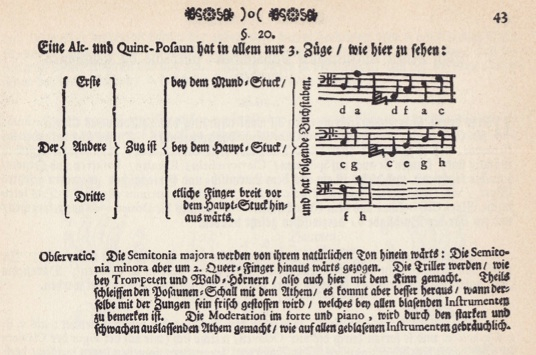
1729—Vienna, Austria: Antonio Caldara uses alto trombone as an obbligato instrument to accompany soprano voice in “Dio, qual sia la ria sentenza” of his oratorio, Naboth (Selfridge-Field, Caldara 138; Carter, Trombone Obbligatos).
1730—Vienna, Austria: Antonio Caldara uses alto trombone as an obbligato instrument with soprano voice in “Dovunque il guardo” of his oratorio, La passione di Gesu Cristo (Selfridge-Field, Caldara 138; Carter, Trombone Obbligatos).
1731—Vienna, Austria: Antonio Caldara uses alto trombone as an obbligato instrument in his aria, “Dal tuo seglio luminoso” from Santa Elena al Calvario (Carter, Trombone Obbligatos).
1731—Vienna, Austria: Antonio Caldara’s aria, “Del fallo m’avvedo” from La morte d’Abel, features alto voice with obbligato alto trombone (Carter, Trombone Obbligatos).
1732—Vienna, Austria: Pietro Casati’s Salve Regina features a soloistic trombone part that lends itself to alto trombone.
1733—Vienna, Austria: Antonio Caldara uses alto trombone as an obbligato instrument the aria “Buon Gesú” of his oratorio, Gerusalemme convertito (Selfridge-Field, Caldara 138; Carter, Trombone Obbligatos).
1734—Vienna, Austria: Antonio Caldara uses alto trombone as an obbligato instrument the aria “Dov’é giá sviene” from his oratorio, San Pietro in Cesarea (Selfridge-Field, Caldara 138; Carter, Trombone Obbligatos).
1734—Vienna, Austria: George Reutter’s aria, “Ah se o da vivere” from Gioas, Ré di Giuda, features solo soprano voice with obbligato alto trombone (Carter, Trombone Obbligatos).
1734—George Reutter’s Missa Sancti Caroli includes a solo movement, “Gratias agimus tibi,” for alto voice, that features virtuoso passagework for the alto trombonist (Guion, Trombone 131).
1736—Vienna, Austria: Antonio Caldara uses alto trombone as one of several obbligato instruments in his setting of Psalm 111/112, Beatus vir qui timet Dominum (Selfridge-Field, Caldara 134).
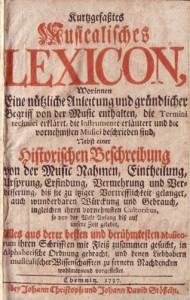 1736—Chemnitz, Germany: The treatise Kurtzgefasstes musicalisches Lexicon, usually attributed to Johann Christoph and Johann David Stössel, is published. Heavily influenced by Walther’s Musikalisches Lexikon, it mentions that alto, tenor, and bass trombone parts can all be played on tenor trombone. However, it also discusses the pitch and positions of the true alto and bass trombones, clearly instruments considered to be in the key of D: “Alto and bass trombone have the same three positions, with d, a, d’, f’, a’, and d” in first position; c, g, c’, e’, g’, c” in second; and f and b in third” (Guion 36-39).
1736—Chemnitz, Germany: The treatise Kurtzgefasstes musicalisches Lexicon, usually attributed to Johann Christoph and Johann David Stössel, is published. Heavily influenced by Walther’s Musikalisches Lexikon, it mentions that alto, tenor, and bass trombone parts can all be played on tenor trombone. However, it also discusses the pitch and positions of the true alto and bass trombones, clearly instruments considered to be in the key of D: “Alto and bass trombone have the same three positions, with d, a, d’, f’, a’, and d” in first position; c, g, c’, e’, g’, c” in second; and f and b in third” (Guion 36-39).
1738—Erfurt, Germany: Johann Philipp Eisel, in his text Musicus autodidactos, oder der sich selbst informirende Musicus, describes the alto trombone as an instrument pitched in D: “What kind of slide positions do an alto and bass have? As anticipated, they also have three positions, which are done in one and the same way as the first ones described. The first position, or to speak more clearly of it, if the trombone is not extended at all, the range has D, A, D, F#, A, D, and in the alto clefs or notes after each other are D, A, D, F#, A, C, D” (Guion, Trombone 43; Eisel 72). Eisel also includes the following about clefs: “What is to be noted concerning the clefs? Nothing more than this, that the alto trombone has the alto clef as prescribed in the parts, where as the quint and quart trombones generally have the bass clef as prescribed in the parts. Whoever understands then that which was stated before will also be able to find their way easily in this” (Guion, Trombone 44; Eisel 72).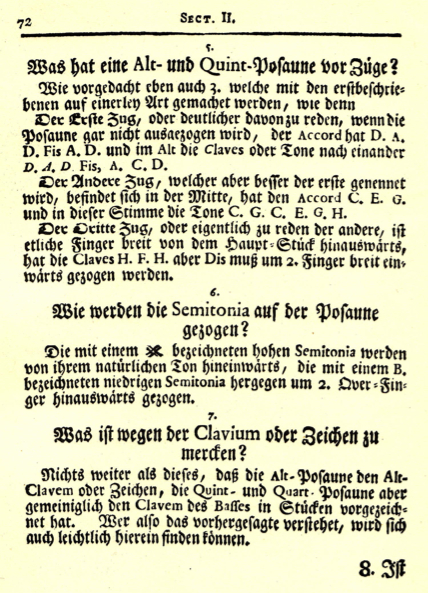
1738—Vienna, Austria: Luca Antonio Predieri’s aria, “Dio sol ne porge aita” from I Sacrificio d’Abramo, features solo alto voice with alto trombone obbligato (Carter, Trombone Obbligatos).
1742—Vienna, Austria: Franz Ignaz Tuma, Sonata a 2 violini e 2 tromboni. The top trombone part lends itself to alto trombone.
1742—Vienna, Austria: Franz Tuma’s Messa della morte is performed. The requiem requires a solo alto trombone with solo alto voice in the “Tuba mirum” section (Smithers, Mozart’s Orchestral Brass).
1743—Zeitz/Leipzig, Germany: The Stadtpfeifer has an opening. They commission Johann Gottlieb Görner, the Leipzig university music director, to write a test composition that contains one solo section for each of the following wind instruments (with string accompaniment): trumpet, alto trombone, cornett, violin, oboe, and horn (Collver 51; Nicholson, The Unnatural Trumpet).
1743—Vienna, Austria: Franz Tuma’s Messa della morte is again performed. The requiem requires a solo alto trombone with solo alto voice in the “Tuba mirum” section (Smithers, Mozart’s Orchestral Brass).
1754—Bethlehem, Pennsylvania: Trombones play for the first time in the community of Bethlehem, during the August 31 celebration of the Single Brothers’ Festival. The 4 trombones played—a soprano, an alto, a tenor, and a bass—are presumably new instruments purchased recently from Europe (Peucker, The Role 174).
c. 1755—Vienna, Austria: Georg Wagenseil, court composer at the Imperial Court, writes Concerto for alto trombone (Wigness 19).
 c. 1755-85—Leipzig, Germany: Johann Friedrich Doles, a former student of J.S. Bach and successor to Bach at Leipzig, writes 27 works that call for all four sizes of trombones (soprano, alto, tenor, bass) (Carter, Trombone Ensembles of the Moravian).
c. 1755-85—Leipzig, Germany: Johann Friedrich Doles, a former student of J.S. Bach and successor to Bach at Leipzig, writes 27 works that call for all four sizes of trombones (soprano, alto, tenor, bass) (Carter, Trombone Ensembles of the Moravian).
 1757—Salzburg, Austria: Leopold Mozart authors a “Report on the Present State of the Musical Establishment at the Court of His Serene Highness the Archbishop of Salzburg,” wherein he makes the following comment about trombones: “To the choir singers belong, finally, three trombonists, namely, to play the alto-, tenor- and bass-trombone, which must be taken care of by the master of the town waits with two of his subordinates” (Eisen, Mozart’s Salzburg Orchestras).
1757—Salzburg, Austria: Leopold Mozart authors a “Report on the Present State of the Musical Establishment at the Court of His Serene Highness the Archbishop of Salzburg,” wherein he makes the following comment about trombones: “To the choir singers belong, finally, three trombonists, namely, to play the alto-, tenor- and bass-trombone, which must be taken care of by the master of the town waits with two of his subordinates” (Eisen, Mozart’s Salzburg Orchestras).
1759—Vienna, Austria: Franz Tuma’s Messa della morte is again performed. The requiem requires a solo alto trombone with solo alto voice in the “Tuba mirum” section (Smithers, Mozart’s Orchestral Brass).
1761—Vienna, Austria: Gluck uses trombone (a single alto trombone) prominently in his ballet Don Juan (Guion, Trombone 229).
1762—Leopold Mozart, Concerto for alto trombone or viola (part of larger Serenata).
c. 1763—Michael Haydn composes Larghetto for alto trombone as part of his incomplete Sinfonia No. 4. The full title for the trombone movement is Larghetto a Trombone Concerto (Guion, Trombone 140). It is possibly written for Salzburg trombonist Thomas Gshlatt (Donley Thomas).
1763-64—London, England: The entry for Sackbut in A New and complete dictionary of arts and sciences says, “Sackbut, a musical instrument of the wind-kind, being a sort of trumpet, though different from the common trumpet both in form and size: it is fit to play a bass, and is contrived to be drawn out and shortened, according to the tone required, whether grave or acute. The Italians call it trombone, and the Latins tuba ductilis….There are sackbuts of different sizes, distinguished by the epithets primo or I’, secundo or II’, terzo or III’, &c. or I’, 2′, 3′, &c. (New and complete 2827).
1764—Michael Haydn, Concerto for alto trombone (part of larger Divertimento).
1767—Salzburg, Austria: The skeptical Archbishop locks 11-year-old Mozart in a room by himself to see if he can really compose without help from his father. Mozart writes the cantata Die Schuldigkeit des ersten Gebots, K 35, which uses solo alto trombone in Christ’s aria, “Jener Donnerworte Kraft.”
1767—Vienna, Austria: Gluck writes for the traditional trio of alto, tenor, and bass to evoke associations of ecclesiastical/supernatural in oracle scene of opera Alceste. The overture features relatively independent trombone parts and 3rd act features prominent obbligato for alto trombone.
1768—Wachovia, North Carolina: The Moravian settlement in Wachovia receives their first set of trombones (treble, alto, tenor, and bass). The event is singled out for special mention in the congregation’s Memorabilia, or year’s summary of activities: “During the year we have received from Europe a set of trombones, and their use on solemn days and festivals has strengthened and edified our congregation” (Gombosi, A Day of Solemn Thanksgiving 8).
1769—Vienna, Austria: Johann Georg Albrechtsberger writes Concerto for alto trombone (Wigness 22).
 1769—Leipzig, Germany: Johann Friedrich Doles, J. S. Bach’s second successor in the Leipzig Cantorate, holds an audition for a vacancy in the Stadtpfeifer. He requires the 2 finalists to play a concerto for horn, oboe, or flute; the violin part of a trio; a concerted chorale on slide trumpet and bass viol; and a chorale on soprano, alto, tenor, and bass trombones” (Guion, Trombone 154). Regarding one of the candidates, the examiner writes, “He cannot manage the concerted Choral on the Zugtrompete, and has to do the best he can on an alto trombone.” Of the other he writes, “He played the simple Choral well on the discant, alto, tenor, and bass trombones” (Terry 36; Bate 230).
1769—Leipzig, Germany: Johann Friedrich Doles, J. S. Bach’s second successor in the Leipzig Cantorate, holds an audition for a vacancy in the Stadtpfeifer. He requires the 2 finalists to play a concerto for horn, oboe, or flute; the violin part of a trio; a concerted chorale on slide trumpet and bass viol; and a chorale on soprano, alto, tenor, and bass trombones” (Guion, Trombone 154). Regarding one of the candidates, the examiner writes, “He cannot manage the concerted Choral on the Zugtrompete, and has to do the best he can on an alto trombone.” Of the other he writes, “He played the simple Choral well on the discant, alto, tenor, and bass trombones” (Terry 36; Bate 230).
1771—Berngrund, Saxony: An E-flat alto trombone is manufactured by Johann Fiebig. A photograph and physical description of the instrument, now held at the National Music Museum in South Dakota, is available on the museum’s website (Herbert, Trombone Appendix 1).
1777—Salzburg, Austria: In a letter to his son, Wolfgang, Leopold Moazrt writes the following about a performance of Michael Haydn’s Missa Sancti Hieronymi: “I liked the whole mass very much, as there were six oboists, three double basses, two bassoons and the castrato who has been taken on for six months at one hundred gulden a month. Ferlendis and Sandmayr played the oboe solos. The oboist at Lodron’s, a certain student, the chief watchman and Oberkirchner were the oboists in the orchestra. Cassel and the choirmaster Knozenbry were the double basses, seated near the organ and beside the trombones; Estlinger was there with his bassoon; Hofner and Perwein were seated beside the oboists on the violinists’ platform. What I particularly liked was that, since oboes and bassoons resemble very much the human voice, the tutti seemed to be a very strongly supported chorus of voices, as the sopranos and altos, strengthened by the six oboes and the alto trombones, admirably balanced the number of tenor and bass voices; and the pieno was so majestic that I could have easily done without the oboe solos. The whole affair lasted an hour and a quarter and I found it far too short, for it is really an excellent composition” (Anderson, The Letters of Mozart and His Family, 352). For a slightly different translation of the letter that also uses the term “alto trombones,” see Karl August Rosenthal, “The Salzburg Church Music of Mozart and His Predecessors.” The Musical Quarterly, Vol. 18, No. 4 (Oct., 1932), 559-577. According to Trevor Herbert, “In fact, the cover of the autograph score lists ‘3 Tromboni tutti obblig.’” (Herbert Trombone, 352).
 1790—Vienna, Austria: Johann Georg Albrechtsberger writes his treatise, Sämmtliche Schriften über Generalbass (Methods of harmony, figured bass, and composition), wherein he says the following about trombone: “The first trombone should go with the alto, the second with the tenor, and the third, which is now scarcely in use, with the vocal bass. This instrument requires rather slow than quick notes, and admits of but few forced notes, which the trumpets alone produce readily. A quick movement must never be given to it in obligato pieces” (Albrechtsberger 264). He also writes, “The Trombone (Posaunen, tromboni) are of three kinds: bass, tenor, and alto. In every position of the slide, the trombone yields four, five, or six different sounds….The compass of the bass trombone is from E1, through every semitone, up to G3; and of the alto trombone from F2 up to E-flat4. Braun and Frölich have written methods or schools. Ahlsdorf, Bolke, Braun, Dueller, Frölich, Hörbeder, Micke, Schmitt, Seeger, Segner, Ulbrich, etc. have handled this instrument skillfully” (Albrechtsberger 290).
1790—Vienna, Austria: Johann Georg Albrechtsberger writes his treatise, Sämmtliche Schriften über Generalbass (Methods of harmony, figured bass, and composition), wherein he says the following about trombone: “The first trombone should go with the alto, the second with the tenor, and the third, which is now scarcely in use, with the vocal bass. This instrument requires rather slow than quick notes, and admits of but few forced notes, which the trumpets alone produce readily. A quick movement must never be given to it in obligato pieces” (Albrechtsberger 264). He also writes, “The Trombone (Posaunen, tromboni) are of three kinds: bass, tenor, and alto. In every position of the slide, the trombone yields four, five, or six different sounds….The compass of the bass trombone is from E1, through every semitone, up to G3; and of the alto trombone from F2 up to E-flat4. Braun and Frölich have written methods or schools. Ahlsdorf, Bolke, Braun, Dueller, Frölich, Hörbeder, Micke, Schmitt, Seeger, Segner, Ulbrich, etc. have handled this instrument skillfully” (Albrechtsberger 290).
c. 1795—Paris, France: Trombonist André Braun writes his method, Gamme et Méthode pour les Trombonnes. The earliest modern trombone method, it specifically states that the alto trombone is in E-flat, the tenor and bass in B-flat. An influential method book—it informs several later methods, including Fröhlich and Nemetz (see 1811 and 1827, below)—the method book also provides an alto trombone position chart clearly showing an instrument in E-flat (see below image; public domain). Editions are subsequently published in German and Italian (Weiner, Braun; Weiner, Braun Revisited).
c. 1795—France: The earliest book of etudes written specifically for trombone, François René Gebauer’s Six trios pour trios trombones extraits de 50 leçons pour la trombone bass, alto & tenor, is published.It is issued as a companion to André Braun’s Gamme et Méthode pour let Trombones (see below image; public domain) (Weiner, Gebauer).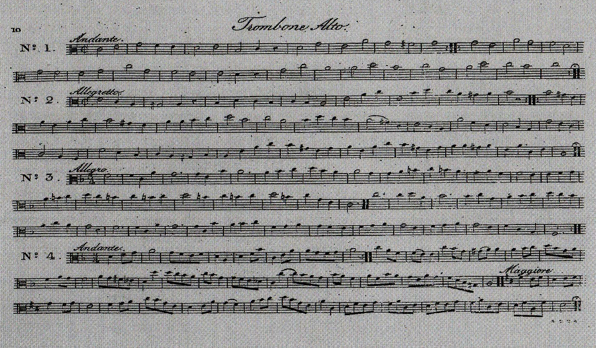
1802—Frankfurt, Germany: Heinrich Christoph Koch describes an alto trombone in D in his Musikalisches Lexikon: “On the alto or quint trombone, the notes receive a different relationship to each other with the three just-described slide positions, for the first provides d, a, d’, f’, a’ and c”; the second c, g, c’, e’, g’, and b’; and the third f and b” (Guion 82).
1803—Vienna, Austria: Joseph Leopold Eybler’s Requiem in C minor, which includes alto, tenor, and bass trombone, is performed at the funeral of Emperor Leopold II (Chase 197).
1809—Beethoven’s Symphony No. 5 is the first orchestral work by a major composer to utilize trombones. It calls for 3 trombones—alto, tenor, and bass.
1810—Beethoven specifically refers to 3 separate trombones—alto, tenor, and bass—in a letter to his publisher about trombone parts for his oratorio, Christ on the Mount of Olives. The original German reads “Alt, Tenor, Bass,” bracketed to the word “Posaunen” (Beethoven, Letters 95).
c. 1811—Bonn, Germany: Joseph Fröhlich writes his method, Vollständige theoretisch-pracktische Musikschule, which includes extensive pedagogical material for the trombone family. Fröhlich is somewhat contradictory. While he says, “In modern times, the three kinds of trombone are made similar in size in many places, and always similar in construction,” he later clearly states that the alto trombone is an instrument in E-flat: “Almost all of the foregoing [about the tenor trombone] is also true of the alto trombone, except that it is a fourth higher, making the high notes even easier to get, and its fundamental is E-flat” (Guion, Trombone 112-113). Finally, in his trombone position charts, he clearly shows a tenor trombone in B-flat and an alto trombone in E-flat (Guion 114-117, 300-309).
1812—Linz, Austria: Beethoven writes his Drei Equale for 4 trombones, a work commissioned by Kappelmeister Glöggl of the Linz cathedral. Glöggl’s son, who later becomes a music publisher in Vienna, verifies that alto, tenor and bass are the instruments commonly in use, mentioning that in his father’s “collection of old instruments he had a soprano and a quart trombone, whereas only alto, tenor and bass trombones were commonly used.” He continues, “Beethoven wanted to hear an Aequale such as was played at funerals in Linz, and one afternoon when Beethoven was expected to dine with us, my father appointed three trombone players and had them play an Aequale as desired…” (Thayer 541).
1818—England: The Prince Regent’s Band of George IV, said to be the finest band in Europe, is headquartered at the Pavilion at Brighton. It includes 4 trombones: soprano, alto, tenor, and bass (Carse, The Prince Regent’s Band).
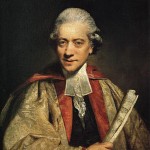 1819—London, England: Charles Burney, author of the musical entries in Abraham Rees’s Cyclopaedia, mentions the entire family of trombones: “The instrument is made of brass, of which there are five sorts: canto, alto, tenor, base, and double-base. It is much used in the large churches of Germany. They can produce all the tones and semitones in gradation. The manner of writing for them is the same as for different voices, and on the same staff of five lines” (Guion, Trombone 92).
1819—London, England: Charles Burney, author of the musical entries in Abraham Rees’s Cyclopaedia, mentions the entire family of trombones: “The instrument is made of brass, of which there are five sorts: canto, alto, tenor, base, and double-base. It is much used in the large churches of Germany. They can produce all the tones and semitones in gradation. The manner of writing for them is the same as for different voices, and on the same staff of five lines” (Guion, Trombone 92).
c. 1820—London, England: The Royal Artillery Band, which is comprised of 39 players, includes one alto trombone, tenor trombone, and bass trombone (Dudgeon, Keyed Bugle 29).
1824—Vienna, Austria: Ludwig van Beethoven composes Symphony No. 9, which includes prominent use of alto, tenor, and bass trombone.Historian Thurston Dart notes, “Few concert-goers probably realize that of all the instruments they hear in Beethoven’s ninth symphony, for instance, the only ones whose sounds have not changed since the symphony was first performed in 1824 are the kettle-drum, the triangle, and the trombone. All the others have been transformed, some more and some less, and even if the symphony is played with the same number of instruments and voices that were used in 1824, the resultant sound will be quite different in quality” (Dart, Interpretation 34).
1826—Vienna, Austria: Ignaz von Seyfried, in his revision of Albrechtsberger’s treatise of 1790 (Sämmtliche Schriften), clarifies the pitch of the alto trombone as E-flat, appending the below alto trombone position chart (see below image; public domain) (Albrechtsberger-Seyfried). Not only was Seyfried in the unique position of having been a pupil of Albrechtsberger’s, but he proceeded to become an active Viennese composer and conductor as well. “His versatility,” explains Grove’s, “won him a unique place in Vienna’s musical life.” He regularly conducted at least 2 orchestras in Vienna, supplying them with numerous works himself, and was on friendly terms with many prominent musicians of Vienna, including Mozart and Beethoven. Seyfried conducted the premiere of Fidelio, along with many other early performances of important works of the era (New Grove, Seyfried 184).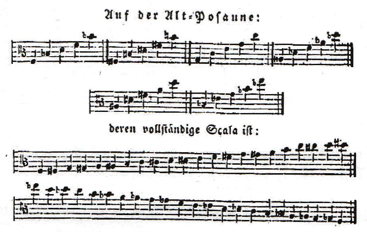
1827—Vienna, Austria: Andreas Nemetz writes his trombone method, Neueste Posaun-Schule. A mostly unoriginal work derived from earlier methods of Fröhlich and Braun, it differs from those methods (and the vast majority of other written works) in that it categorizes all 3 trombones (alto, tenor, bass) as B-flat instruments, supplying only a single position chart (Weiner, Nemetz).
c. 1829—Sweden: Two wind players from the Swedish Royal Court Orchestra, Carl Anton Philipp Braun and Bernard Henrik Crusell, collaborate on Adagio and Polonaise for solo Kenthorn and 2 keyed bugles, 4 horns, 2 trumpets, and alto, tenor and bass trombone. Swedish cavalry and artillery regiments throughout the country likely adapt this instrumentation. The same instrumentation is also used in Braun’s arrangement of the Adagio movement of Beethoven’s Septet, Op. 20 (Dudgeon, Keyed Bugle 166).
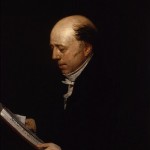 1829—Salzburg, Austria: British musician and publisher Vincent Novello attends Mass at the Salzburg Cathedral. The trombones, which include a full complement of alto, tenor, and bass, receive special praise and are the only wind instruments present in Novello’s detailed account of the ensemble: “The Orchestra was placed in the right-hand Gallery near the Altar against one of the large Pillars which support the Dome. It consisted of two first Violins, a second Violin, Tenor [viola] and Double Bass (no Violoncello), three trombones (alto, tenor and bass), and the Organ….The best performers were the three trombone players, who produced a fine tone and added much grandeur to the general effect” (Novello 303-4).
1829—Salzburg, Austria: British musician and publisher Vincent Novello attends Mass at the Salzburg Cathedral. The trombones, which include a full complement of alto, tenor, and bass, receive special praise and are the only wind instruments present in Novello’s detailed account of the ensemble: “The Orchestra was placed in the right-hand Gallery near the Altar against one of the large Pillars which support the Dome. It consisted of two first Violins, a second Violin, Tenor [viola] and Double Bass (no Violoncello), three trombones (alto, tenor and bass), and the Organ….The best performers were the three trombone players, who produced a fine tone and added much grandeur to the general effect” (Novello 303-4).
1830—Hector Berlioz writes Symphony Fantastique. Regarding the orchestration of the top trombone part, he says, in an early document listing the instrumentation, “The alto trombone part must not be played on a big trombone, as is often done in France: I demand a true alto trombone” (see below image) (Macdonald 210; Massip 33).
1830—London, England: Auguste Bertini, a musician active in France, Italy, and England, publishes New System for… All Musical Instruments, an instruction book for a variety of instruments. He mentions alto, tenor, and bass trombones, the alto apparently pitched in E-flat (Myers, Fingering Charts).
c. 1835—Paris, France: An E-flat alto trombone is manufactured by Charles-Joseph Sax (Haine 125).
1835—Hector Berlioz composes Le cinq mai, in which he begins his practice of writing for 3 trombones in tenor and bass clefs rather than alto, tenor, and bass. It is presumed that it is at this point that he intends all 3 parts to be played on tenor trombone, as specified in the Requiem, rather than performed on alto, tenor, and bass (Macdonald 209).
 1837—London, England: George Hogarth, Scottish music critic and musicologist, specifies the keys of the members of the trombone family in an article in The Musical World, the preeminent British music journal of the time: “Thus the bass trombone gives the fundamental note G…The tenor trombone is in C, a fourth higher than the bass trombone; and the alto trombone is in F, a fourth above the tenor trombone…” (Hogarth 132).
1837—London, England: George Hogarth, Scottish music critic and musicologist, specifies the keys of the members of the trombone family in an article in The Musical World, the preeminent British music journal of the time: “Thus the bass trombone gives the fundamental note G…The tenor trombone is in C, a fourth higher than the bass trombone; and the alto trombone is in F, a fourth above the tenor trombone…” (Hogarth 132).
1837—Paris, France: Jean-Georges Kastner, a French composer and theorist, writes Traité Général d’Instrumentation, an orchestration treatise that predates that of Berlioz and is adopted into the curriculum at the Paris Conservatory. He provides a position chart for alto trombone clearly indicating an instrument pitched in E-flat (see below image; public domain) (Kastner-Woodward, Traité 313). Kastner also writes about the security and purity of sound when using alto trombone in its middle register instead of tenor in its upper register: “If they are used in their middle register as much as possible, both alto and tenor trombone create a superb effect, because the tones can always be attacked with frankness and purity [franchise et pureté]” (Kastner-Woodward, Traité 250).
1839—Paris, France: The following 4 people are listed as trombonists in the Opéra Comique: “Carteret (alto), Buisson (alto et ténor), Marchal (ténor et basse), Marez (ditto)” (Carse, Orchestra 493).
1839—London, England: A catalogue issued by D’Almaine & Co. includes several tutors for wind instruments. The tutor for trombone, A new and complete instruction book for the Three Trombones, is by G. Foraboschi, “member of the Philharmonic Societies of Rome and the principal cities of Italy.” It shows tenor trombone in C, bass trombone in G, and alto trombone in F, and does not mention valve trombone (Poole, Catalogue).
1839—Frankfurt, Germany: In a collection of scores for wind band, a 119-page manuscript score of C. Ostreich’s Simphonia für Blasinstrumente includes parts scored specifically for alto trombone, tenor trombone, and bass trombone (Dudgeon, Keyed Bugle 41).
c. 1840—Paris, France: Hartman’s Méthode elémentaire de trombone includes the following information about the pitch and usage of the alto trombone: “There are three types of trombones, alto, tenor or bass, and contrabass. The alto trombone is in E-flat, a fourth above the tenor, tenor trombone is in B-flat, and contrabass trombone in E-flat, a fifth below the tenor trombone. The tenor trombone being nearly the only one in use, it will then be, without question, only about this [one] in this work.” The method book is dated by University of Cambridge’s library catalog as c. 1840, and by Trevor Herbert as “1845?” (Hartman, Methode; Herbert, The Trombone 327).
1840—Karlsruhe, Germany: Gustav Schilling, a German music lexicographer, author, and editor, publishes his Lehrbuch der allgemeinen Musikwissenschaft. The book provides information about the alto trombone, including a position chart, shown below, clearly showing an instrument in E-flat. The chart, which starts with seventh position (labeled a) and proceeds chromatically up to first (labeled g), seems to be inaccurate for seventh position, but clearly points to an e-flat alto trombone with all the other positions (see below image; public domain) (Schilling 59).
1840—Stuttgart, Germany: Jean-George Kastner, the French composer and theorist, reportedly hears a chorale played each day from a balcony by a quartet consisting of cornett, alto trombone, tenor trombone, and bass trombone: “In 1840, while I was in Stuttgart, I heard every day a concert of sacred music performed by four musicians who, according to custom, climbed the balcony of the tower to play a chorale, of which the first voice was played by the cornett, and the others by alto, tenor, and bass trombones” (Kastner, Danses des morts 213). Kastner specifically describes the alto trombone one year earlier in his Traité Général d’Instrumentation as an instrument pitched in E-flat (see 1837, above).
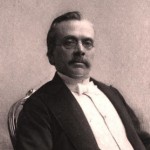 1842—Lyon, France: Jules Riviere, a French musician who later becomes active as a conductor in England, joins the orchestra at the Lyons Opera House as a violinist. Something of a trombonist himself and later a friend of the renowned trombonist, Antoine Dieppo, Riviere takes special note of the makeup of the orchestra’s trombone section, “the first trombone player having an instrument in F alto, the second a B [sic] tenor, and the third a G bass” (Riviere 58).
1842—Lyon, France: Jules Riviere, a French musician who later becomes active as a conductor in England, joins the orchestra at the Lyons Opera House as a violinist. Something of a trombonist himself and later a friend of the renowned trombonist, Antoine Dieppo, Riviere takes special note of the makeup of the orchestra’s trombone section, “the first trombone player having an instrument in F alto, the second a B [sic] tenor, and the third a G bass” (Riviere 58).
1842-43—Manufacture date of an alto trombone in E-flat, labeled “C. W. Moritz/ Königl.-Hof Instrumentenmacher, Friedrichsgracht No 50 in Berlin” (Kölnisches Stadtmuseum 252).
1843—Berlin, Germany: Hector Berlioz visits Berlin, where he hears 2 bass trombones in the opera orchestra. Complaining that there are none in Paris, he says, “Parisian musicians refuse to play an instrument that is so tiring to the chest. Prussian lungs are evidently more robust than ours.” He is not, however, impressed with the balance of the trombone section there; he reports: “Their combined volume of tone is so great as to obliterate the alto and tenor trombones playing the two upper parts. The aggressive tone of one bass trombone would be enough to upset the balance of the three trombone parts as written by composers nowadays. But there being no ophicleide at the Berlin Opera, they give the part to a second bass trombone. The effect of having two of these formidable instruments one above the other (the ophicleide part being frequently written an octave below the third trombone) is disastrous. You hear nothing but the bottom line; even the trumpets are all but drowned. When I came to give my concerts I found that the bass trombone was much too prominent—although in the symphonies I was using only one—and had to ask the player to sit so that the bell of the instrument was facing into his stand, which acted as a sort of mute, while the alto and tenor trombonists stood up to play with their bells pointing over the top of their stands. Only in this way could all three parts be heard” (Macdonald 213).
1843—Hudson, Ohio: An advertisement in the Ohio Observer labeled simply “Boston,” (though offering a Cleveland street address) mentions numerous musical instruments for sale, including “Alto & Tenor Trombone” (Ohio Observer).
 1844—Paris, France: Composer-musicologist Adrien de La Fage’s entry on trombone in the Encyclopédie des gens du monde offers the following information about the key and usage of alto trombone: “Those dimensions are those of the most used trombone, which is to say the tenor trombone—which in practice is used as a bass trombone; that which is used in orchestras where there is only one trombone…But in the large [or great] orchestras, where three trombones are used, other than the preceding that effectively plays the tenor part, there is the alto trombone, in F, which is a fifth above, and the bass trombone at the inferior octave from the alto trombone; although the bass part is most often played on a tenor trombone” (special thanks to Maximilien Brisson for the translation) (vol. 22, part 1, 292).
1844—Paris, France: Composer-musicologist Adrien de La Fage’s entry on trombone in the Encyclopédie des gens du monde offers the following information about the key and usage of alto trombone: “Those dimensions are those of the most used trombone, which is to say the tenor trombone—which in practice is used as a bass trombone; that which is used in orchestras where there is only one trombone…But in the large [or great] orchestras, where three trombones are used, other than the preceding that effectively plays the tenor part, there is the alto trombone, in F, which is a fifth above, and the bass trombone at the inferior octave from the alto trombone; although the bass part is most often played on a tenor trombone” (special thanks to Maximilien Brisson for the translation) (vol. 22, part 1, 292).
1844—Paris, France: Jean-Georges Kastner, the French composer and theorist, writes a Supplement to his Traité Général d’Instrumentation.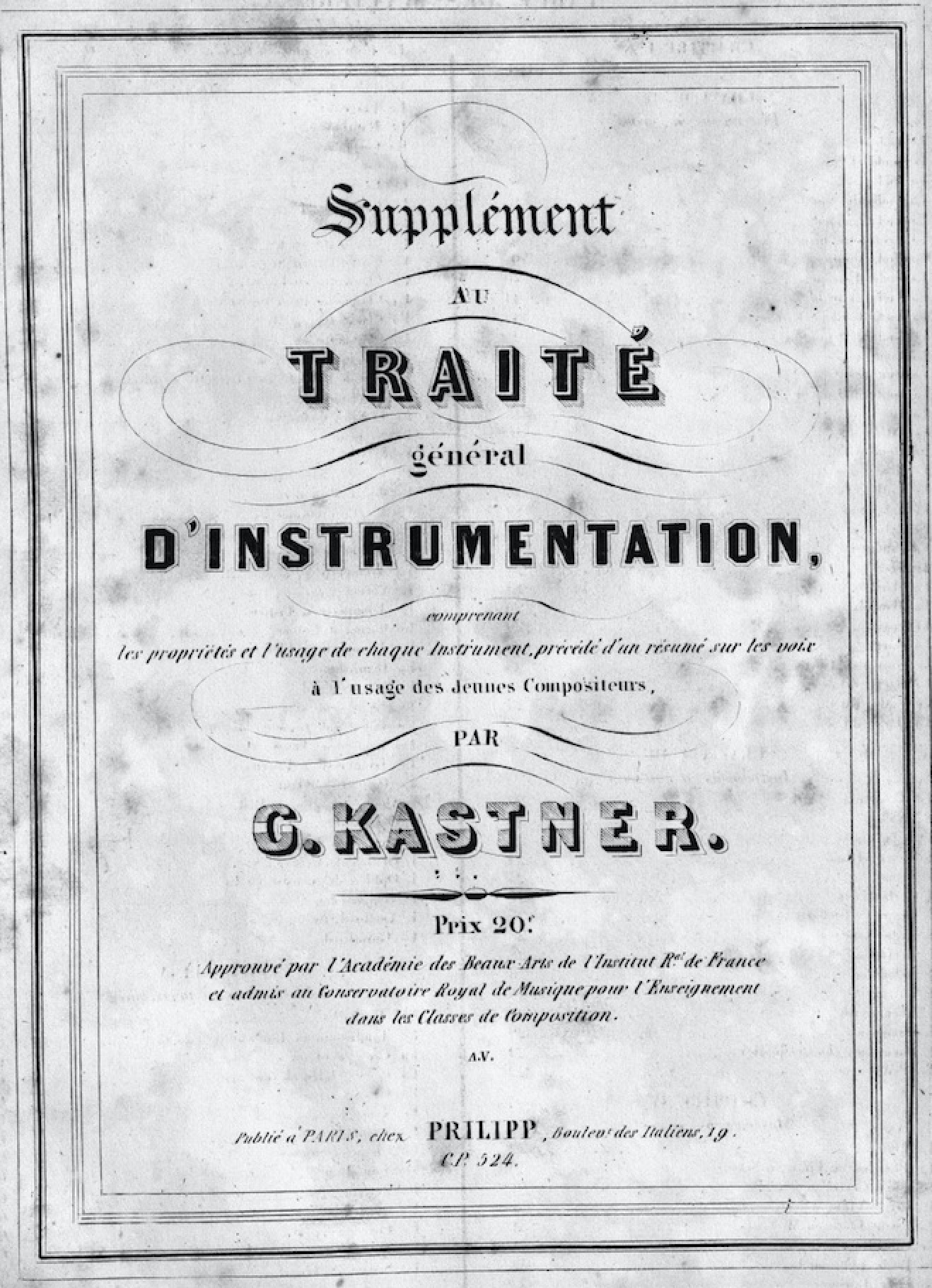
As in the original treatise, Kastner places the alto trombone clearly in the E-flat orbit: “In general, in France, the first position of the alto trombone provides the following notes [E-flat harmonic series], but one finds others that feature a first position that is a tone higher [F harmonic series], and consequently all the degrees in the same proportion” (see below image; public domain; p. 40).
Likewise, Kastner places the valve alto trombone in E-flat and F (p. 42). Kastner also mentions that, unfortunately, the alto is much more common in Germany than in France: “The alto trombone is in general use in Germany, but is only found in France in very few orchestras, which is very unfortunate because the tenor trombone may not play as high, and composers are deprived of using [notated B-F], notes that would benefit them greatly” (p. 40). He reiterates on the following page that this absence of alto trombone is a negative: “And the alto trombone and bass trombone, which are widespread in Germany, are most unusual in France. It is understood that this is a great disadvantage for our composers” (p. 41). Finally, he adds that, in general, 3 tenor trombones are used in French trombone sections, reiterating that this is negative (difficulty/embarrassment): “In general, French composers use only tenor trombone, for which they write in three parts, but they often continue to indicate by the designations of alto, tenor, and bass, which has given rise to some singular difficulty [embarras], especially in the bass part” (p. 41).
1844—Paris, France: Hector Berlioz describes an alto trombone in E-flat (“small trombone, or alto trombone in E-flat”) in his highly influential Treatise on Modern Instrumentation and Orchestration (see below image; public domain) (Berlioz-Clarke 152). Although he offers a mixed opinion about the alto trombone, he does have a few positive things to say, mentioning that the instrument’s high notes are “very useful” and thus bemoaning, “it is a matter for regret therefore that the alto trombone is now to be found in very few of our French orchestras” (Macdonald 208). In his discussion of valve alto trombone (which he explains is pitched in E-flat or F), he is also complimentary: “Melodic solos are frequently written for the alto valve trombone. If well phrased, a melody can have considerable charm on this instrument.” Although the statement is in reference to valve alto trombone, Berlioz adds, “But it is a mistake to believe it would have any less charm on the slide trombone in the hands of a true virtuoso…” (Macdonald 228).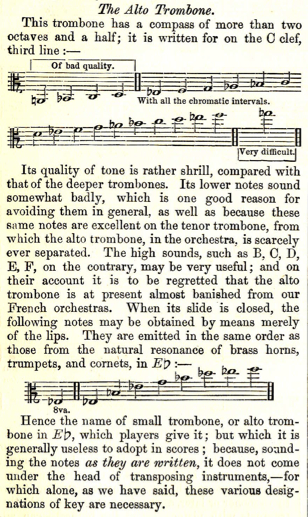
1844—Hector Berlioz, in his orchestration textbook, includes 4 alto trombones, 6 tenor trombones, and 2 bass trombones in his “dream orchestra” (Macdonald 329).
1844—Paris, France: Kresser’s 12 Quatuors pour quatre Cornets a pistons is scored for 4 cornets or 3 cornets and alto trombone. The partbook for the lowest part is marked “Piston ou Trombon[one] alto a Pistons en Mi.” The composer’s first name is not known, although the title page of the collection states that he was a trumpeter in the Académie Royale de Musique, professor at the Gymnase Musical Militaire, and a member of the Société des Concerts in Paris (Kresser).
1846—Paris, France: Victor Caussinus, an ophicleide specialist, writes the method book, Solfège-méthode progressif: pour l’enseignement du cornet à pistons, de la trompette chromatique, saxhorns ou bugle à pistons, du sax-tromba our trombone-alto à pistons. Caussinus places the alto valve trombone in E-flat or F (see below image; public domain) (Caussinus 13).
1848—London, England: When Berlioz conducts his Symphonie funebre et triomphale, the extensive trombone solo in the second movement is played by Koenig on alto trombone (Macdonald 229).
1848—Paris, France: Jean Georges Kastner’s treatise on military music, Manuel Général de Musique Militaire, includes prints of a number of different types of trombones used in military music, including rear-facing trombone, double-slide trombone, and several types of valve trombones (see below image; public domain). The note on the bottom of the page reads, “There are, as we know, three types of trombone, alto, tenor, and bass; but it is simply a difference in size and not in the shape of the instrument (Kastner, Militaire Pl. XVII).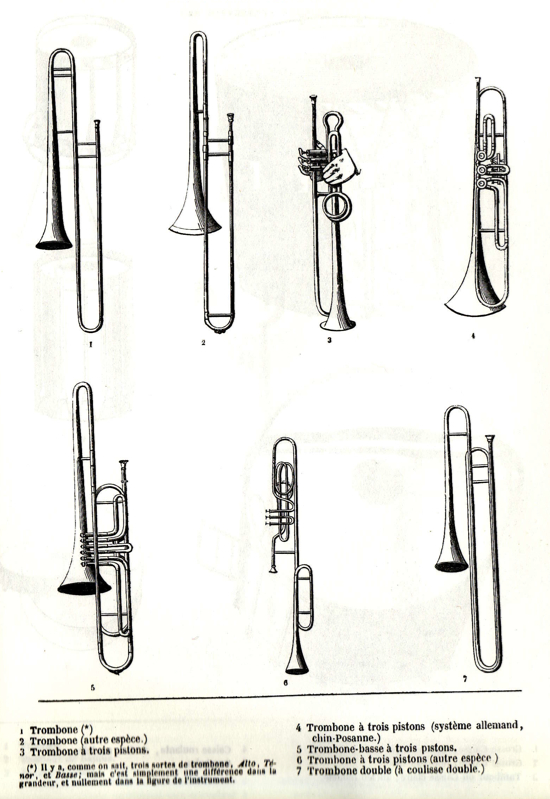
1848—Germany: Jean Georges Kastner, in a listing of the typical instrumentation of the German cavalry bands of this time, specifies that bands include “3 trombones (alto, tenor, bass)” (Dudgeon, Keyed Bugle 38).
1852—Milwaukee, Wisconsin: Among a number of instruments lost to members of the Milwaukee Musical Society in a fire is a “trombone alto” (Milwaukee Daily Sentinel).
1853—New York: Allen Dodworth shows position charts for alto trombone in F, tenor trombone in C, tenor trombone in B-flat, and bass trombone in G, in his book, Dodworth’s Brass Band School (see below image; public domain).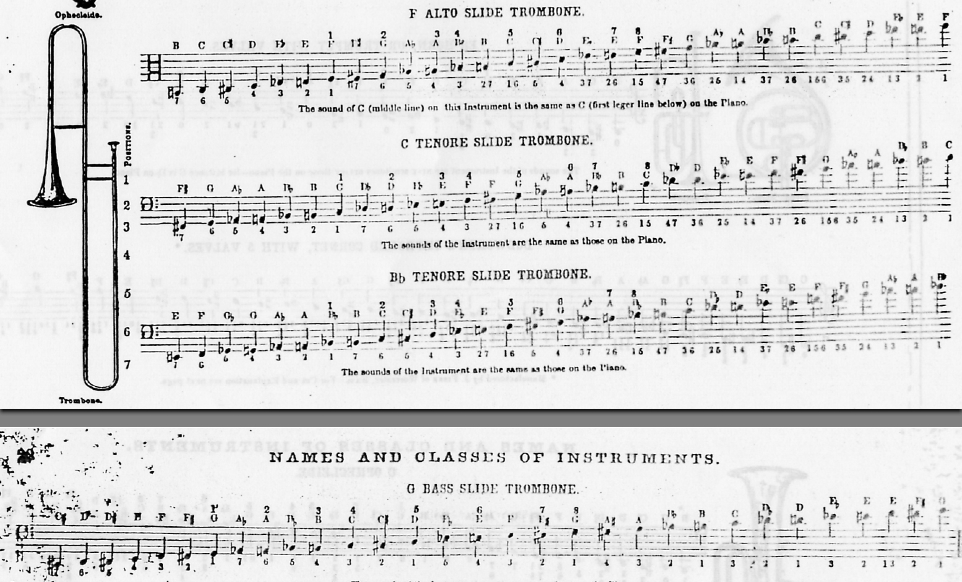
1853—Leipzig, Germany: Ferdinand Gleich, a German composer and author, writes his Handbuch der modernen Instrumentirung für Orchester und Militairmusikcorps. In his section on alto trombone, he mentions that music for alto trombone is notated in alto clef, that the alto trombone is an e-flat instrument (although it is non-transposing), and that it has the following chromatic range (public domain image; Gleich 48-49):
1855—England/Austria: In Novello’s translation of Albrechtsberger’s collected writings, J. G. Albrechtsberger’s Collected Writings on Thorough-bass, Harmony, and Composition, edited by Seyfried, the overtone series and range of the alto trombone is diagrammed, clearly showing an instrument in E-flat. The overtone series diagram begins with 6th position and proceeds to 1st (see below image; public domain) (Albrechtsberger-Novello 253).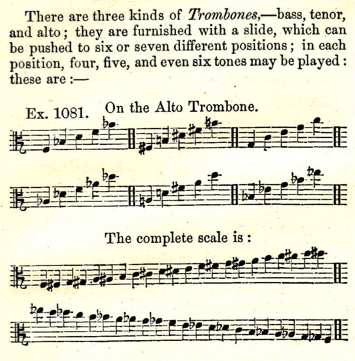
1855—England: The Band of George IV is headquartered at the Pavilion at Brighton. It includes 6 trombones: an alto, a tenor, and 4 basses (Carse, The Prince Regent’s Band).
1857—Manchester, England: An advertisement for manufacturer Joseph Higham includes the following entry: “16 Trombone. Alto. F or E-flat. German Silver slides.” The number corresponds to a graphic of a trombone that is the shortest in a grouping of three slide trombones (see below image; public domain) (The Strangers Guide to Manchester, with a Map of the Environs, and Illustrations of Public Buildings 63).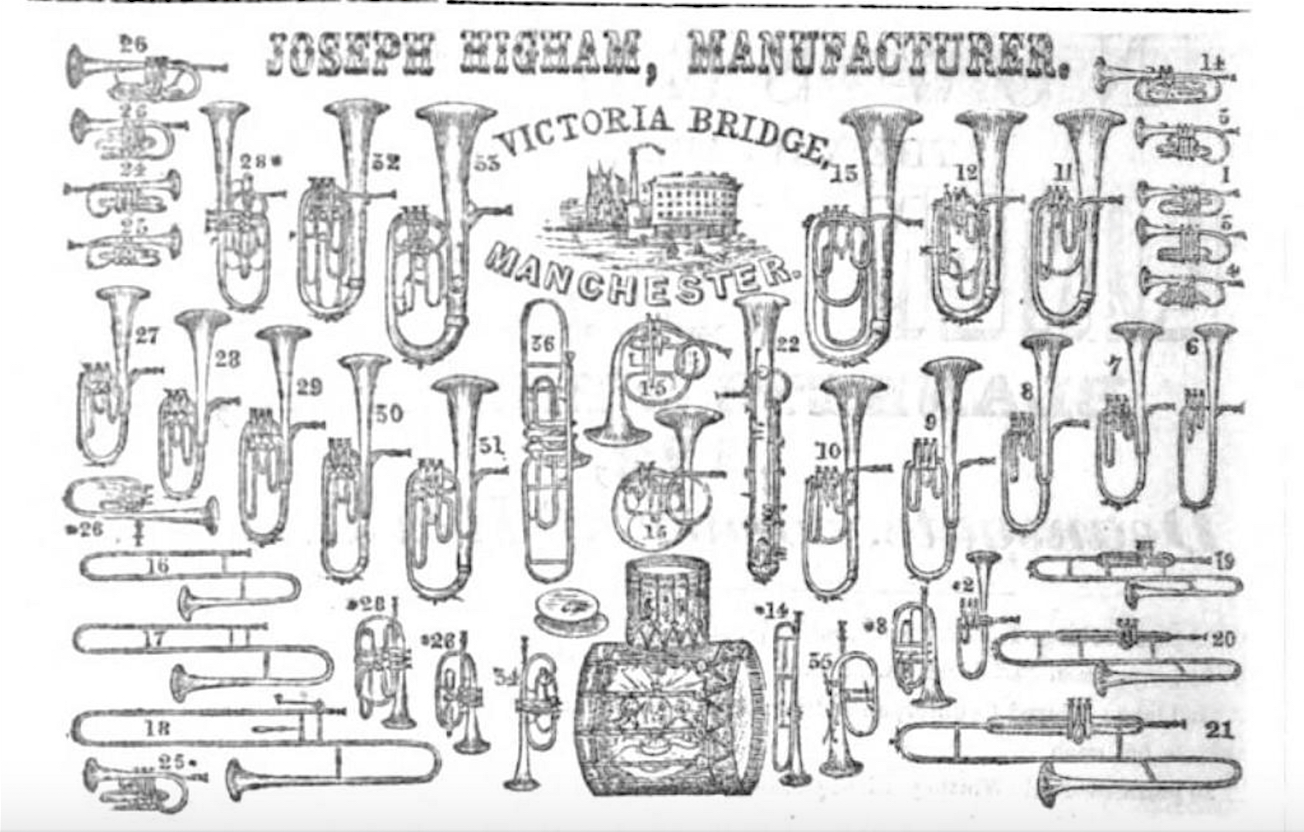
1857—England: Henry Distin’s instrument catalog shows offerings of slide alto trombone and valve alto trombone in both E-flat and F (Myers, Horn Function 250).
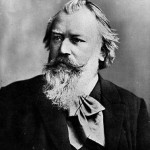 1859—Hamburg, Germany: Johannes Brahms, discussing instrumentation in a letter to Theodor Avé Lallemant, insists, “On no account 3 tenor trombones! One genuine little alto trombone and, if possible, also a genuine bass trombone” (“Daß keine 3 Tenor Posaunen kommen! Eine ächte kleine Alt-Pos. u. wo möglich auch eine ächte Bass-Pos.”) (Avins 127). For similar wording by another composer of the era, see Berlioz’s note about a “true alto trombone” for Symphony Fantastique, above (1830).
1859—Hamburg, Germany: Johannes Brahms, discussing instrumentation in a letter to Theodor Avé Lallemant, insists, “On no account 3 tenor trombones! One genuine little alto trombone and, if possible, also a genuine bass trombone” (“Daß keine 3 Tenor Posaunen kommen! Eine ächte kleine Alt-Pos. u. wo möglich auch eine ächte Bass-Pos.”) (Avins 127). For similar wording by another composer of the era, see Berlioz’s note about a “true alto trombone” for Symphony Fantastique, above (1830).
1859—Gounod’s opera, Faust, uses 3 trombones in orchestra, plus 2 e-flat altos and 1 tenor in a military band that appears on stage in fourth act.
1859—London, England: Charles Mandel, Professor at the Royal Military School of Music, discusses alto trombone in his Treatise on the Instrumentation of Military Bands. Although he describes altos in E-flat, E, and F, as well as offering position charts for each, he comments that “at the present time, instead of an alto, tenor, and bass trombone, three tenor trombones are employed…” (Mandel 65). Later he mentions that “[the alto] is superseded by valved alt-horns, or by the tenor trombone; while, again, the bass trombone, being too troublesome, is replaced by the bass valved instruments, or the tenor trombone” (Mandel 67). However, he concludes with his own unique proposal of a section of different sizes of trombones in relatively close keys: “For my own part, therefore, I should be inclined to employ the three trombones, with a slight difference of key; choosing the first in C or D flat, the second in B flat, and the third as tenor-bass, supported by a bass trombone, on which some of the bass notes might be doubled by means of the lower octave (Mandel 68).
c. 1860—New York: John F. Stratton offers two different models of “E-flat Alto Trombone” in his musical instrument catalog, one under the heading of “J. Latour Paris, France,” and another under the heading of “Stratton’s ‘Concerto’ Band Instruments” (University of California, Santa Barbara Romaine Collection).
c. 1860—New York: In a catalog labeled “Appendix to our Musical Merchandise Catalogue,” John F. Stratton offers an “E-flat Alto Trombone” under the category of “Stratton ‘Concerto’ Trombones.” Pictured is an engraving of a valve alto trombone that is shorter than the B-flat tenor pictured (University of California, Santa Barbara Romaine Collection).
c. 1860—Merthyr Tydfil, Wales: The “B Series” part books of the famous Cyfarthfa Band include “Alto trombone,” “First Tenor Trombone,” “Second Tenor Trombone,” and “Bass Trombone” (Herbert, Cyfarthfa; Dudgeon, Keyed Bugle 32).
1862—Leipzig, Germany: Franz Ludwig Schubert’s Katechismus der musik-instrumente includes the following alto trombone position chart, clearly showing an instrument pitched in E-flat (public domain image) (Schubert, Ketechismus 72). This is in agreement with the author’s Die Instrumentalmusik of 1865 (see below). The question posed above the position chart, just below the heading, is, “Which notes do the seven positions produce?”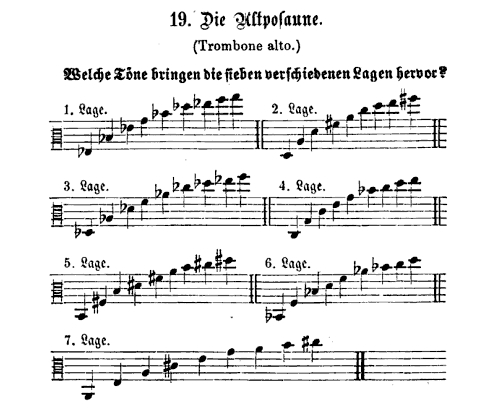
1863—Paris, France: François Gevaert, who later becomes director of the Brussels Conservatory, writes his influential Treatise on Instrumentation, which includes a slide position chart and range diagram of the alto trombone, revealing an instrument in E-flat (See below 2 images; public domain; Gevaert 241-242).

1865—Lancashire, England: A photograph of the 4th Lancashire Rifle Volunteers Band shows trombone players with alto, tenor and bass trombones (see below image; public domain).
1865—Leipzig, Germany: Franz Ludwig Schubert’s Die Instrumentalmusik: in ihre Theorie und ihrer Praxis oder die Hauptformen und Tonwerkzeuge der Concert-, Kammer-, Militär- und Tanzmusik includes the following alto trombone position chart, clearly showing an instrument pitched in E-flat (public domain image) (Schubert, Instrumentalmusik 122). This is in agreement with his Katechismus der musik-instrumente of 1862 (see above).
1867—London, England: F. J. Fetis, in his orchestration guide published in the periodical The Musical World, says, “The compass of the trombone alto, like the bass trombone, is not alike in all countries; in Germany the dimensions of the tubes being larger than in France, and the manner in which some portions of it are disposed being different, the bass trombone descends to C, while in France, it only descends to E…The alto trombone is a fifth higher than the bass trombone, and descends to B-flat, reaching up to E-flat….Three parts are generally written for the trombones, which are called bass trombone, tenor trombone, and alto trombone. The tenor trombone part is sometimes played upon the bass trombone. Some composers write these three parts on the one set of lines, with the F, or bass clef; others the tenor part with the key or C upon the fourth line; others write upon the same set of lines, the tenor and bass trombone parts, and on the next lines write the alto trombone part. Others again write each part separately, and in the key of each instrument” (Fetis 477).
1867—Bethlehem, Pennsylvania: A photograph of 3 trombonists of the Moravian community shows, from left to right, Charles F. Beckel, Jedidiah Weiss, and Jacob Till, with an empty chair in honor of their deceased colleague, Timothy Weiss. At least one of the instruments pictured is very likely an alto trombone (see below image; public domain) (Moravian Archives, Bethlehem, PA).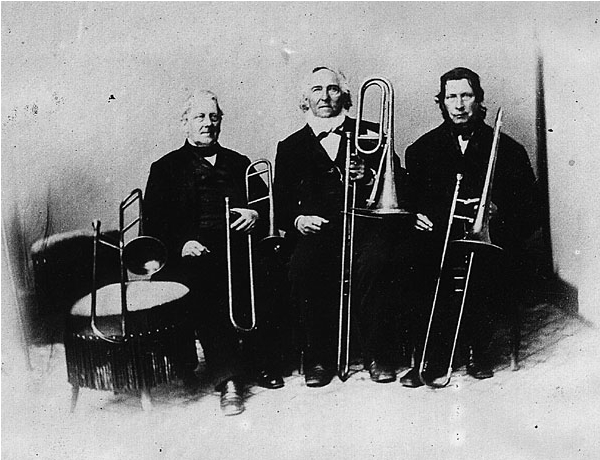
1870s—Manchester, England: A valve alto trombone is manufactured by Joseph Higham, bearing the marking, “Joseph Higham, 127 Strangeways, Manchester, Exhibition prize medal awarded London 1852 and Dublin 1863” (see below image; used by permission of Brass Players Museum: www.neillins.com/brass.htm).
1870—London, England: Adam Wirth’s trombone method, Posaunen-Schule für Alt, Tenor und Bass-Posaune…Instruction Book of the Simple and Valve-Trombone, written in both German and English, is apparently intended for a wide audience. It includes a “Table of the different Trombones” that shows alto trombone in E-flat (like the vast majority of written sources), valve and slide tenors in B-flat, and bass in F (see below image; public domain) (Herbert, Trombone 192).
1871-88—England: Production records for Boosey & Co. show a surprisingly high number of alto trombones: 89 alto valve trombones in E-flat, 3 alto slide trombones in E-flat, and 2 alto slide trombones in F (Myers, Brasswind).
1874—Bethlehem, Pennsylvania: The Moravians at Bethlehem, Pennsylvania, an engraving by A.R. Waud published in Harper’s Weekly, depicts trombone ensembles performing from a church tower (“Funeral Notes”) and at a graveside service (“Burial Service”). The lower picture seems to show different sizes of trombones, and Moravians are known to have performed on the full family of soprano, alto, tenor, and bass trombones (see below detail; public domain) (Harper’s Weekly, 1874, Issue 4/18, p. 346).
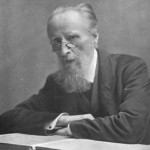 1877—London, England: Ebenezer Prout, soon to become professor of composition at the Royal Academy of Music and later Guildhall School of Music, writes the following about alto trombone in his text, Instrumentation: “Formerly a soprano trombone seems to have been known, as we find it indicated in some of Bach’s scores. It is now, however, entirely obsolete; and even the alto trombone is not employed in France, though in this country and in Germany it is frequently to be met with in the orchestra. THE ALTO TROMBONE is in the key of E-flat—i.e., the natural sounds produced by the difference of embouchure when playing with the slide closed for part of the harmonic series of that key….Three trombones are usually employed in the orchestra: in England and Germany, an alto, a tenor, and a bass; and in France, three tenor trombones. If a student bear this fact in mind he will see the reason for the difference in the treatment of the instruments which he will find in French scores (e.g., those of Auber or Hérod), as compared with those of German masters.” (Prout, Instrumentation 87-88). Regarding notation and clef of the trombone family, he mentions several different practices, while concluding that “many give a separate line to each instrument, and write each with its proper clef” (Prout, Instrumentation 88).
1877—London, England: Ebenezer Prout, soon to become professor of composition at the Royal Academy of Music and later Guildhall School of Music, writes the following about alto trombone in his text, Instrumentation: “Formerly a soprano trombone seems to have been known, as we find it indicated in some of Bach’s scores. It is now, however, entirely obsolete; and even the alto trombone is not employed in France, though in this country and in Germany it is frequently to be met with in the orchestra. THE ALTO TROMBONE is in the key of E-flat—i.e., the natural sounds produced by the difference of embouchure when playing with the slide closed for part of the harmonic series of that key….Three trombones are usually employed in the orchestra: in England and Germany, an alto, a tenor, and a bass; and in France, three tenor trombones. If a student bear this fact in mind he will see the reason for the difference in the treatment of the instruments which he will find in French scores (e.g., those of Auber or Hérod), as compared with those of German masters.” (Prout, Instrumentation 87-88). Regarding notation and clef of the trombone family, he mentions several different practices, while concluding that “many give a separate line to each instrument, and write each with its proper clef” (Prout, Instrumentation 88).
1878—Chicago, Illinois: Lyon & Healy, an instrument distributor and manufacturer, includes an alto valve trombone, specifically labeled an E-flat instrument, in its commercial catalog (see below image; public domain) (Lyon & Healy 1878, p. 23).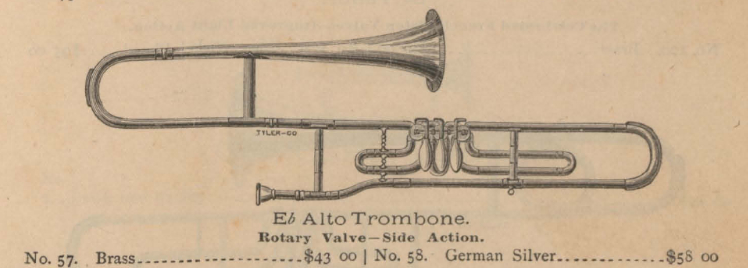
1878—Paris, France: A catalog from Jérome Thibouville-Lamy, French instrument manufacturer and distributor, offers alto valve trombones in F and E-flat (Thibouville 1878, p. 130).
c. 1879—London, England: Besson’s London factory produces an alto trombone in E-flat with “Medals of Honour” stamped on the instrument. A Besson stock book, 1887-1895, indicates production and sales of alto trombone, and a Besson advertising poster from c. 1885 features an E-flat alto trombone, labeled, “Slide Trombone, in E-flat (alto),” as well as a valve alto trombone, labeled, “Valve Trombone, in F or E-flat” (Horniman Museum, London; Myers and Eldredge, Brasswind Production).
 1879—London, England: George Bernard Shaw, the well-known playwright, literary critic, and music critic, writes, “Another abuse which occurs in the same ill regulated family is the desuetude of the bass slide trombone and the alto trombone, both of which are frequently supplanted by tenors; a proceeding quite comparable to relegating the viola and double bass parts to violoncellos, which, nevertheless, few conductors would care to attempt, except perhaps with a second rate English opera troupe in the provinces. Some composers, by writing for three tenor trombones (perhaps making a virtue of a necessity) have seemed to undervalue the distinction between the three varieties; but the individuality of the alto is as marked as that of any other instrument in the orchestra; and nothing can supply the place of the bass trombone” (italics added) (Shaw Unpublished 46-47).
1879—London, England: George Bernard Shaw, the well-known playwright, literary critic, and music critic, writes, “Another abuse which occurs in the same ill regulated family is the desuetude of the bass slide trombone and the alto trombone, both of which are frequently supplanted by tenors; a proceeding quite comparable to relegating the viola and double bass parts to violoncellos, which, nevertheless, few conductors would care to attempt, except perhaps with a second rate English opera troupe in the provinces. Some composers, by writing for three tenor trombones (perhaps making a virtue of a necessity) have seemed to undervalue the distinction between the three varieties; but the individuality of the alto is as marked as that of any other instrument in the orchestra; and nothing can supply the place of the bass trombone” (italics added) (Shaw Unpublished 46-47).
 1879—London, England: William Alexander Barrett, British writer, critic, choirmaster, and Vicar-Choral of St. Paul’s Cathedral, writes the following about alto trombone in his An Introduction to Form and Instrumentation:“The Alto Trombone is not so frequently used in the orchestra as it should be, the players preferring the convenience of the Tenor instrument, the tone of which, though good, lacks the soft brilliancy of the Alto” (Barrett 73-74).
1879—London, England: William Alexander Barrett, British writer, critic, choirmaster, and Vicar-Choral of St. Paul’s Cathedral, writes the following about alto trombone in his An Introduction to Form and Instrumentation:“The Alto Trombone is not so frequently used in the orchestra as it should be, the players preferring the convenience of the Tenor instrument, the tone of which, though good, lacks the soft brilliancy of the Alto” (Barrett 73-74).
1879-1890—London, England: Sir George Grove publishes the first edition of his influential Dictionary of Music and Musicians. The trombone article, written by William Stone, includes a position chart for alto trombone, tenor trombone, bass trombone in G, and bass trombone in F. Stone mentions that the alto trombone is pitched in F or E-flat, and the alto positions shown in the position chart are clearly for an instrument in E-flat (see below image; public domain) (Grove 1st ed. 177).
1879-1888—London, England: Robert Hunter’s Encyclopaedic Dictionary, one of the most influential English dictionaries of its type during this era, mentions that the alto trombone is known as an E-flat instrument: “There are three kinds of trombones, called after their compass the alto, tenor, and bass trombones….The alto trombone has a compass of more than two octaves and a half, and is also known as the trombone in E-flat. It is written in the c clef, third line” (Hunter 215).
1879-1905—New York: A valve alto trombone in E-flat with 3 Périnet valves is imported and sold by August Pollmann. It is engraved “August Pollmann’s Light Action New York” and is similar in appearance to offerings by mail-order distributors Montgomery Ward (see 1895, below) and Sears & Roebuck (see 1897, below) (Libin 97-98; Heyde, Metropolitan). See the Metropolitan Museum’s website for a photograph of this instrument.
1880—New York: The catalog for Busch & Dodworth’s “Band Instrument” holdings indicates that the manufacturers offer a valve alto trombone pitched in E-flat. Notice that the below image says “Same Model in E-flat pitch, same as E-flat alto” (see below image; public domain) (Busch & Dodworth 13).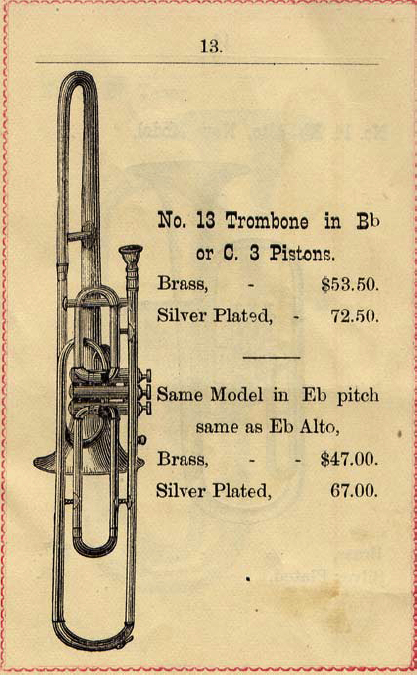
1880—Chicago, Illinois: Lyon & Healy, an instrument distributor and manufacturer, includes 2 alto valve trombone models in its catalog. Both are labeled as E-flat instruments (see below image; public domain) (Lyon & Healy 1880, 33).
1882—Raleigh, North Carolina: Dodworth of New York advertises several instruments for sale, including an alto trombone in E-flat (Raleigh News and Observer).
1882—Leipzig, Germany: Hugo Riemann, influential musicologist and professor at Leipzig University, publishes his Dictionary of Music, wherein he specifically mentions that “the alto trombone in E-flat (orchestral compass A to E-flat)” is “now somewhat rare” (Riemann, Dictionary 809). Riemann also mentions E-flat alto trombone in his Handbuch of 1919 (see below).
1883—Leipzig, Germany: Heinrich Saro, German composer, military bandmaster, and trombonist, publishes his text on instrumentation for military bands, Instrumentations-Lehre für Militair-Musik, which describes an alto trombone in E-flat (see below image; public domain): “The alto trombone is rarely represented in military music. It has an effective range of two octaves and is written in alto clef. If the slide is closed, we obtain the following series of notes [see diagram, below]. The second position gives the pitch of half a tone lower, etc. Trills are not written for the alto trombone; likewise it is not possible to play the following figure: [see diagram, below]” (Saro 17).
1883—London, England: The Musical Standard, a wide-ranging British musical periodical with a publication run of 72 years (1862-1933), publishes the following as part of an unsigned review of the Leeds Festival: “The constitution of the Leeds orchestra for large choral works has proved as before to be a satisfactory one; and generally it is that adopted at Birmingham, with the wood wind doubled. Sir M. Costa’s first experiment included the doubling of the brass as well, but experience proved this to be unnecessary, so the brass remains the same as usual, save that two trumpets and two cornets are secured to form the upper group. Sir Arthur Sullivan deserves to be complimented upon his efforts to secure the proper trio of alto, tenor, and bass trombones. The French custom of using three in B flat, and the usual plan in England of employing two tenors and one bass, are not altogether satisfactory. The bass trombone in G is necessary to do justice to the lower notes below F, and the alto is equally necessary for the proper sustentation of the upper part, for the tenor cannot produce with effect the high B natural, C, etc., which appear in the scores of the great masters, as in ‘Elijah’” (emphasis added; Leeds Festival 240).
1883—Cincinnati, Ohio: Oscar Coon publishes his text, Harmony and Instrumentation, and says the following about the trombone in the orchestra: “In this country, the Alto and Bass are seldom seen, and the three Trombone parts are played on Tenor Trombones….The prevailing fashion of getting as much noise as possible from a few instruments seems to sanction this abuse of one of the noblest instruments in the orchestra.” He indicates that the alto trombone is an E-flat instrument, offering a diagram of the pitch range (see below; public domain) (Coon 73).
1884—Boston, Massachusetts: John C. Haynes & Co. publishes its Illustrated Catalogue of Musical Instruments. Included among the trombone holdings is an alto trombone, specified as an E-flat instrument (see below image; public domain) (Haynes 1884, p. 43).
 1884—Scotland: Frederick Niecks, a German music scholar who spends the bulk of his career in Scotland, holding positions in the Mackenzie String Quartet and, later, at the University of Edinburgh, writes his Concise Dictionary of Musical Terms. In the trombone entry, he specifies the key of the alto trombone (“alto trombone in the key of E flat”) and makes the common connection with alto clef: “The alto trombone is generally noted in the alto clef.” He also points out, “Three is the usual number of trombones employed in the orchestra. But the bass trombone is becoming more and more rare, and instead of it a second tenor trombone is frequently employed. In France we find even three tenor trombones. Besides the slide trombones there are also valve trombones, which, however, are inferior with regard to tone” (Niecks 246).
1884—Scotland: Frederick Niecks, a German music scholar who spends the bulk of his career in Scotland, holding positions in the Mackenzie String Quartet and, later, at the University of Edinburgh, writes his Concise Dictionary of Musical Terms. In the trombone entry, he specifies the key of the alto trombone (“alto trombone in the key of E flat”) and makes the common connection with alto clef: “The alto trombone is generally noted in the alto clef.” He also points out, “Three is the usual number of trombones employed in the orchestra. But the bass trombone is becoming more and more rare, and instead of it a second tenor trombone is frequently employed. In France we find even three tenor trombones. Besides the slide trombones there are also valve trombones, which, however, are inferior with regard to tone” (Niecks 246).
1884—Boston, Massachessetts: J. B. Claus, whose “The Structure of the Orchestra,” appears in Musical Herald, states, “In the old scores, the trombone parts are written in alto, tenor, and bass clef respectively, and the instruments used were of corresponding registers. The alto trombone, the smallest in size, was in the pitch of E-flat” (Claus).
c. 1885—Philadelphia, Pennsylvania: A catalog of the Henry Distin Manufacturing Co. labeled A Complete Line of Highest Grade Band Instruments & Cornets offers an E-flat Alto Valve Trombone. The tenor instrument, in contrast, is listed as being in B-flat (Distin, Complete Line) (University of California Santa Barbara Romaine Trade Catalog Collection).
1885—London, England: A price list for London manufacturer Silvani & Smith lists slide alto trombones in E-flat and F. Also offered are B-flat tenor (both slide and valve) and G bass (both slide and valve) (University of California Santa Barbara Romaine Trade Catalog Collection).
1885—London, England: An article by E.H. Turpin in the music journal, The Musical Standard, mentions “the use of the alto trombone in F or E flat and the G or F bass trombone” (May 9, 1885).
1885—London, England: Boosey & Co. makes 13 different “Case Model” trombones (instruments made in collaboration with trombonist George Case), including alto in E-flat; slide trombone in C; trombones in B-flat small, [standard], medium and bass; bass slide trombone in G; and bass slide trombone in F. One unique feature of these instruments is the tuning slide at the foot of the hand slide (Myers, Brasswind).
1885—Sunderland, England: A photograph of the Sunderland Monkwearmouth Salvation Army Band shows trombone players with alto, tenor and bass trombones (see below image; public domain).
1886—New York: An “Illustrated Catalogue” for C. Bruno & Son offers three different E-flat alto valve trombones (“Style A,” “Style B,” and “Style C”), as well as a slide alto trombone in E-flat (see below 4 images; public domain) (Bruno 17, 31, 52-53).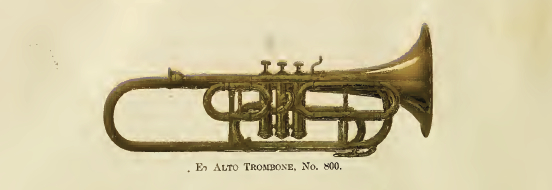
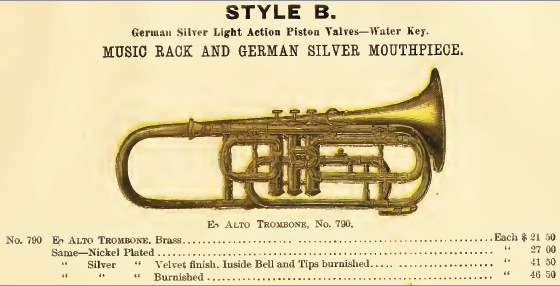


1887—Paris, France: A catalog from manufacturer Jérome Thibouville-Lamy targeting “American patrons” includes 3 different valve alto trombones, all pitched in the key of E-flat (one each under the categories of “Good Ordinary Quality,” “First Quality,” and “Superior Quality”) (University of California Santa Barbara Romaine Trade Catalog Collection).
1888—Paris, France: François Sudre offers valve alto trombone in his catalogue. The catalogue specifies that the instrument is pitched in e-flat (see below image; public domain) (Sudre, July 1888, p. 3).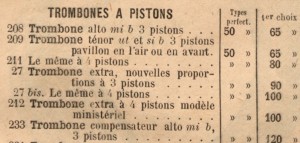
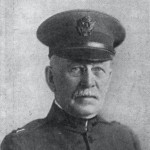 1888—New York: Arthur Clappé, a former faculty member of London’s Royal Military School who eventually becomes an influential bandmaster in England, Canada, and the United States, publishes his treatise, The Band Teacher’s Assistant. In his discussion of the trumpet family, he labels the alto trombone an E-flat instrument: “The trumpet family consists of a complete quartet as follows: Soprano trumpet (in almost any key), E-flat alto trombone, B-flat tenor trombone, and G, F, or E-flat bass trombone. It is to be regretted that this family is not used complete in our bands, since it imparts a richness and variety of tonal color, now deficient” (Clappé, Band Teacher’s Assistant 35).
1888—New York: Arthur Clappé, a former faculty member of London’s Royal Military School who eventually becomes an influential bandmaster in England, Canada, and the United States, publishes his treatise, The Band Teacher’s Assistant. In his discussion of the trumpet family, he labels the alto trombone an E-flat instrument: “The trumpet family consists of a complete quartet as follows: Soprano trumpet (in almost any key), E-flat alto trombone, B-flat tenor trombone, and G, F, or E-flat bass trombone. It is to be regretted that this family is not used complete in our bands, since it imparts a richness and variety of tonal color, now deficient” (Clappé, Band Teacher’s Assistant 35).
1888—Bethlehem, Pennsylvania: An engraving published in Harper’s Weekly features the Bethlehem Moravian trombone choir playing by torchlight for arrivals at the Easter Dawn service. Although it is difficult to tell from the image, Moravians traditionally play trombone choir music in sets of soprano, alto, tenor, and bass (see below image; public domain) (Harper’s, March 31, 1888).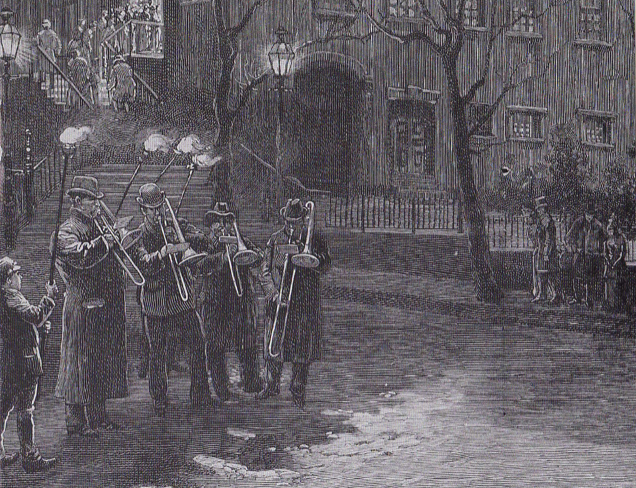
1888—Edinburgh, Scotland: The Encyclopaedia Britannica article on trombone mentions the family of trombones, including alto in F and alto in E-flat: “At present six trombones are more or less in use, viz., the alto trombone in F, the alto in E-flat (formerly in D), the tenor in B-flat (formerly in A), the bass in G, the bass in F (formerly in E), the bass in E-flat (formerly in D)” (Baynes XXIII 587).
1889—Paris, France: Pierre-François Clodomir (1815-1884), a cornet player in the 11th Legion Band of the Paris National Guard and later a teacher at the Lycée Imperial Napoléon, mentions alto trombone in his Manuel Complet (6th ed.). He says the alto, no longer in use, was an instrument pitched in F: “There were formerly four slide trombones that formed a small family: 1) the soprano trombone in B-flat, 2) the alto trombone in F, 3) the tenor trombone in B-flat, 4) the bass trombone in F. The only one employed today is the tenor trombone” (Clodomir 21).
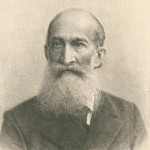 1889—Leipzig, Germany: Salomon Jadassohn, professor at the Royal Conservatory of Music in Leipzig, writes his orchestration text, A Course of Instruction in Instrumentation. The text, soon translated into English, includes information about the alto trombone, including a diagram of the overtone series of the E-flat alto trombone (see below image; public domain; Jadassohn 275). The author states, “Formerly we always had three trombones in the orchestra, namely: alto, tenor, and bass trombone. The last named instrument which is no more in use–as previously remarked above–is admirably replaced by the tuba. The alto trombone is of less frequent use, for its higher notes, such as one-lined B-flat, B and two-lined C can be taken much better by the valve-trumpet (Jadassohn 273).
1889—Leipzig, Germany: Salomon Jadassohn, professor at the Royal Conservatory of Music in Leipzig, writes his orchestration text, A Course of Instruction in Instrumentation. The text, soon translated into English, includes information about the alto trombone, including a diagram of the overtone series of the E-flat alto trombone (see below image; public domain; Jadassohn 275). The author states, “Formerly we always had three trombones in the orchestra, namely: alto, tenor, and bass trombone. The last named instrument which is no more in use–as previously remarked above–is admirably replaced by the tuba. The alto trombone is of less frequent use, for its higher notes, such as one-lined B-flat, B and two-lined C can be taken much better by the valve-trumpet (Jadassohn 273).![]()
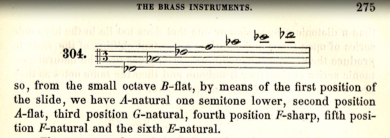
1889—Hamburg, Germany: Carl Schroeder explains the following about alto trombone in his Handbook of Conducting: “There are alto, tenor and bass trombones, and with closed slide these have the following natural notes: Alto Tromb. [shows harmonic series in E-flat]….In many orchestras only tenor trombones are used, and frequently only these are indicated by modern composers. But where the alto and bass trombones are prescribed by the composer, it should be seen to that such are played.” (Schroeder 87).
1889—Quincy, Illinois: Pierre V. Olker’s Musician’s Hand and Text Book mentions alto, tenor, and bass trombones, noting the following about alto: “The E-flat Alto Slide Trombone with a notation in the Alto clef, derives its name from the fact that the tones produced in the closed (first) position, are all intervals of the chord of E-flat major” (Olker 77). An overtone series in E-flat is notated on the following page (see below; public domain image) (Olker 78).
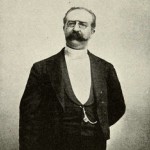 1890—Boston, MA: Louis Charles Elson says the following about trombone in his book, The Theory of Music: “The trombone is at present made in three pitches, alto, tenor, and bass…The alto-trombone is called the E-flat trombone, as, with closed slides, it gives the harmonic series of E-flat…The tenor-trombone is the instrument of this family most used; although this is a faulty arrangement. This is a B-flat trombone, that note being its fundamental…As already seen, the alto-trombone is notated in the alto-clef, the tenor in the tenor, and the bass-trombone in the bass-clef. The trombone has been in use for many centuries, but it was poorly used, even in the last century. The old composers used it in unison with the contra-basses, a barbarous mode of strengthening the bass. Mozart appears to have been the first to have appreciated the instrument, and his use of trombones in his ‘Requiem’ and in the graveyard scene in ‘Don Giovanni’ was the beginning of real trombone-writing” (Elson, Theory 67-68).
1890—Boston, MA: Louis Charles Elson says the following about trombone in his book, The Theory of Music: “The trombone is at present made in three pitches, alto, tenor, and bass…The alto-trombone is called the E-flat trombone, as, with closed slides, it gives the harmonic series of E-flat…The tenor-trombone is the instrument of this family most used; although this is a faulty arrangement. This is a B-flat trombone, that note being its fundamental…As already seen, the alto-trombone is notated in the alto-clef, the tenor in the tenor, and the bass-trombone in the bass-clef. The trombone has been in use for many centuries, but it was poorly used, even in the last century. The old composers used it in unison with the contra-basses, a barbarous mode of strengthening the bass. Mozart appears to have been the first to have appreciated the instrument, and his use of trombones in his ‘Requiem’ and in the graveyard scene in ‘Don Giovanni’ was the beginning of real trombone-writing” (Elson, Theory 67-68).
 1890—London, England: Author George Bernard Shaw writes about trombone in his music criticism column: “The Valkyrie Ride, which came next, excited the audience furiously; but it also made a lady on the orchestra put her fingers into her ears. The lady was quite right. The Valkyrie Ride requires above all things fine trombone-playing—such playing, for instance, as Mr. Manns seldom fails to get at the Crystal Palace from Messrs Hadfield, Geard, and Phasey, who generally contrive to stop short of that brain-splitting bark which detaches itself from the rest of the orchestra, asserting itself rowdily and intrusively in your ear, preventing you from hearing the music, and making you wonder, if you accept the hideous din as inevitable, how Berlioz could ever call such an ignobly noisy instrument ‘Olympian.’ No matter how many fortissimo marks the composer writes, there is no use in forcing the tone of the trombone, unless, indeed, you are to be intentionally hellish, as in Liszt’s Inferno. But if you want to be majestic, as in the Valkyrie Ride and the Francs Juges overture, then it is not to be done by bawling like a mob orator who does not know his business. Why Richter permits forcing, and even encourages it, not only in the Valkyrie Ride but in the first movement of the Tannhäuser overture, can only be explained as the result of his share of original sin. It is not that his players cannot do better: they are always dignified in the Valhalla motif in the Nibeling music. I once heard Herr Müller, Richter’s first trombone, play the ‘oraison’ in Berlioz’ Sinfonie Funebre et Triomphale very finely. But on Monday week the only tolerable brazen sound in the piece came from the other side of the orchestra, where Mr. Geard was playing the bass trumpet part on an alto trombone. During the few bars in which the theme was left to him the lady did not keep her fingers in her ears; and the volume of sound from the orchestra was greater instead of less than when his colleagues were blaring away, because the accompaniment could be heard through his transparent and musical tone, whereas the others drowned everything else with their distracting rattle. I am not squeamish about the quantity of sound that comes from an orchestra: the more thundering its fortissimo, the better I like it. I delight, for example, in Richter’s tremendous handling of the Rienzi overture. But I am fastidious as to the quality of the tone, however voluminous it may be; and, frankly, the Valkyrie Ride might as well be conducted by Buffalo Bill as by Richter, if some regard is not paid to the artistic spirit, if not to the snobbish expression, of Sterndale Bennett’s remark about treating trombone-players as gentlemen. I am aware of the full horror of recommending to Richter a precept by the Mendelssohnian Sterndale Bennett; but I cannot help that: much as I respect Richter, and appreciate the relief he brought us thirteen years ago in the midst of a dire music famine, I am not going to be tromboned out of my senses for him or any conductor alive when the remedy is so easy” (italics added) (Shaw, Music in London, 17-19).
1890—London, England: Author George Bernard Shaw writes about trombone in his music criticism column: “The Valkyrie Ride, which came next, excited the audience furiously; but it also made a lady on the orchestra put her fingers into her ears. The lady was quite right. The Valkyrie Ride requires above all things fine trombone-playing—such playing, for instance, as Mr. Manns seldom fails to get at the Crystal Palace from Messrs Hadfield, Geard, and Phasey, who generally contrive to stop short of that brain-splitting bark which detaches itself from the rest of the orchestra, asserting itself rowdily and intrusively in your ear, preventing you from hearing the music, and making you wonder, if you accept the hideous din as inevitable, how Berlioz could ever call such an ignobly noisy instrument ‘Olympian.’ No matter how many fortissimo marks the composer writes, there is no use in forcing the tone of the trombone, unless, indeed, you are to be intentionally hellish, as in Liszt’s Inferno. But if you want to be majestic, as in the Valkyrie Ride and the Francs Juges overture, then it is not to be done by bawling like a mob orator who does not know his business. Why Richter permits forcing, and even encourages it, not only in the Valkyrie Ride but in the first movement of the Tannhäuser overture, can only be explained as the result of his share of original sin. It is not that his players cannot do better: they are always dignified in the Valhalla motif in the Nibeling music. I once heard Herr Müller, Richter’s first trombone, play the ‘oraison’ in Berlioz’ Sinfonie Funebre et Triomphale very finely. But on Monday week the only tolerable brazen sound in the piece came from the other side of the orchestra, where Mr. Geard was playing the bass trumpet part on an alto trombone. During the few bars in which the theme was left to him the lady did not keep her fingers in her ears; and the volume of sound from the orchestra was greater instead of less than when his colleagues were blaring away, because the accompaniment could be heard through his transparent and musical tone, whereas the others drowned everything else with their distracting rattle. I am not squeamish about the quantity of sound that comes from an orchestra: the more thundering its fortissimo, the better I like it. I delight, for example, in Richter’s tremendous handling of the Rienzi overture. But I am fastidious as to the quality of the tone, however voluminous it may be; and, frankly, the Valkyrie Ride might as well be conducted by Buffalo Bill as by Richter, if some regard is not paid to the artistic spirit, if not to the snobbish expression, of Sterndale Bennett’s remark about treating trombone-players as gentlemen. I am aware of the full horror of recommending to Richter a precept by the Mendelssohnian Sterndale Bennett; but I cannot help that: much as I respect Richter, and appreciate the relief he brought us thirteen years ago in the midst of a dire music famine, I am not going to be tromboned out of my senses for him or any conductor alive when the remedy is so easy” (italics added) (Shaw, Music in London, 17-19).
1891—London, England: Explanatory notes from an exhibition of musical instruments includes the following about the trombone family in England: “The family of trombones consists in the present day of the alto in e-flat or f, the tenor in B-flat, and the bass in G or F. The F bass trombone is in constant use in Germany, but unfortunately is little employed in this country” (Day, Descriptive Catalogue 176).
1893—Leipzig, Germany: Richard Hofmann, professor at the Leipzig Conservatory, writes his instrumentation treatise, Praktische Instrumentationslehre. About the alto trombone Hofmann says, “The alto trombone is the smallest and most easily handled of the trombones now in use, and is written for in the alto clef. It is usually said to be an instrument in E-flat…” He includes an alto trombone position chart, showing an instrument clearly in E-flat (see below image; public domain) (Hofmann part 6, 26). Hofmann also mentions that the valve alto trombone is pitched in E-flat (Hofmann part 6, 45).
1894—Chicago, Illinois: The catalog for Lyon & Healy, an instrument distributor and manufacturer, advertises numerous valve alto trombones, all specified as E-flat instruments. Several bear a resemblance to valve alto trombones offered by other US distributors during the same time period, such as Montgomery Ward and Sears & Roebuck (see 1895, 1897) (Lyon & Healy 1894, 35, 39, 43, 50, 662). In addition, the catalogue offers a slide alto trombone in E-flat, not pictured (Lyon & Healy 1894, 53).

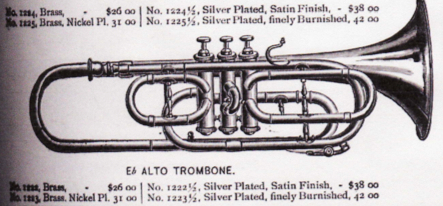
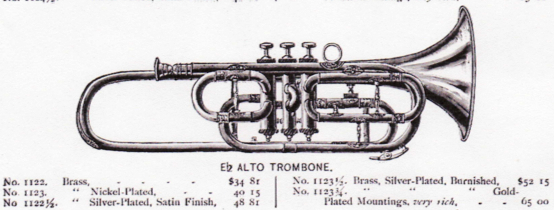

1895—Wildstein, Bohemia (Czech Republic): Hermann Trapp’s musical instrument catalog, 12th edition, offers alto trombones in both F and E-flat (University of California Santa Barbara Romaine Trade Catalog Collection).
 1895—Paris, France: Albert Lavignac, professor at the Paris Conservatory, writes his treatise, La Musique et les Musiciens. About the trombone family he says, “There are three varieties of slide trombone: the alto trombone, the tenor trombone, and the bass trombone, which are each written in the clef suitable for the voice of which they bear the name…” He then offers the range for each, showing an alto trombone apparently in E-flat (he later confirms this, saying the alto is pitched a fourth higher than the tenor), the lowest note being the lowest pitch attainable on an E-flat instrument (excepting pedal notes), and the highest being the 8th partial in first position (compare the tenor trombone range offered, which shows comparable notes in B-flat) (see below image; public domain) (Lavignac 142).
1895—Paris, France: Albert Lavignac, professor at the Paris Conservatory, writes his treatise, La Musique et les Musiciens. About the trombone family he says, “There are three varieties of slide trombone: the alto trombone, the tenor trombone, and the bass trombone, which are each written in the clef suitable for the voice of which they bear the name…” He then offers the range for each, showing an alto trombone apparently in E-flat (he later confirms this, saying the alto is pitched a fourth higher than the tenor), the lowest note being the lowest pitch attainable on an E-flat instrument (excepting pedal notes), and the highest being the 8th partial in first position (compare the tenor trombone range offered, which shows comparable notes in B-flat) (see below image; public domain) (Lavignac 142).
1895—Chicago, Illinois: The popular and widely-distributed Montgomery Ward mail order catalogue includes offerings of 2 different types of valve alto trombones, the first under the subheading of “German Piston Valves” and the other under the subheading of “Improved French Piston Instruments.” Both alto trombones are listed as E-flat instruments (see below; public domain) (Montgomery Ward 249).

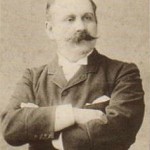 1895—London, England: Widely-traveled musician Algernon Rose reports the following about the alto trombone: “The alto trombone is rarer than it was. It is generally in E-flat, being named after the note it produces when its slide is not drawn out. This instrument is replaced in bands by the valved alt-horn, or its part is played on the tenor trombone” (Rose, Bandsmen 112).
1895—London, England: Widely-traveled musician Algernon Rose reports the following about the alto trombone: “The alto trombone is rarer than it was. It is generally in E-flat, being named after the note it produces when its slide is not drawn out. This instrument is replaced in bands by the valved alt-horn, or its part is played on the tenor trombone” (Rose, Bandsmen 112).
1896—Bethlehem, Pennsylvania: A painting by Alice Barber Stephens depicts the Bethlehem Moravian trombone choir at an Easter Dawn service. Although it is not clear from the painting, Moravians traditionally use soprano, alto, tenor, and bass trombones in trombone ensemble settings. A bass trombone with extension handle is clearly shown in the front row. The tower of the Central Moravian Church, from which the trombone choir frequently performs, can be seen in the background (see below image; public domain) (Sweitzer 8).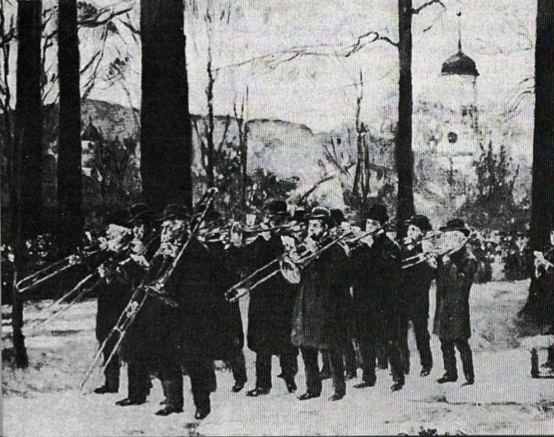
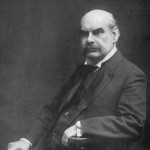 1896—London, England: Frederick Corder, British conductor, writer, and professor of composition at the Royal Academy of Music in London, publishes his orchestration text, The Orchestra and How to Write for It: A Practical Guide. Corder includes a diagram of the range of the alto trombone in E-flat (see below image; public domain), commenting on the rarity of the alto and bass instruments, “It is a great pity that practical reasons have conduced to the almost entire abolition of all save the B-flat trombone; but it cannot be helped, so we must accept the fact.” He bemoans that cornets have to be used to fill in “the valuable high notes of the Alto trombone” (Corder 58).
1896—London, England: Frederick Corder, British conductor, writer, and professor of composition at the Royal Academy of Music in London, publishes his orchestration text, The Orchestra and How to Write for It: A Practical Guide. Corder includes a diagram of the range of the alto trombone in E-flat (see below image; public domain), commenting on the rarity of the alto and bass instruments, “It is a great pity that practical reasons have conduced to the almost entire abolition of all save the B-flat trombone; but it cannot be helped, so we must accept the fact.” He bemoans that cornets have to be used to fill in “the valuable high notes of the Alto trombone” (Corder 58).
1897—Boston, Massachussetts: The John C. Haynes Catalog offers an E-flat alto valve trombone under the label “Hileron.” Under the label “Special,” their least expensive brand, they also offer an E-flat alto valve trombone (University of California Santa Barbara Romaine Trade Catalog Collection).
1897—Königgrätz, Czech Republic: The trade catalog for V.F. Cerveny & Söhne includes an alto trombone pitched in E-flat (University of California Santa Barbara Romaine Trade Catalog Collection).
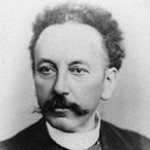 1897—Brussels, Belgium: Victor-Charles Mahillon, Belgian musician, instrument builder, and curator of the Conservatoire museum in Brussels, writes an orchestration text that includes a fingering/position chart for the trombone family of alto, tenor, bass, and contrabass. The chart clearly indicates an alto trombone in e-flat (see diagram below–click for larger image; public domain) (Mahillon 34).
1897—Brussels, Belgium: Victor-Charles Mahillon, Belgian musician, instrument builder, and curator of the Conservatoire museum in Brussels, writes an orchestration text that includes a fingering/position chart for the trombone family of alto, tenor, bass, and contrabass. The chart clearly indicates an alto trombone in e-flat (see diagram below–click for larger image; public domain) (Mahillon 34).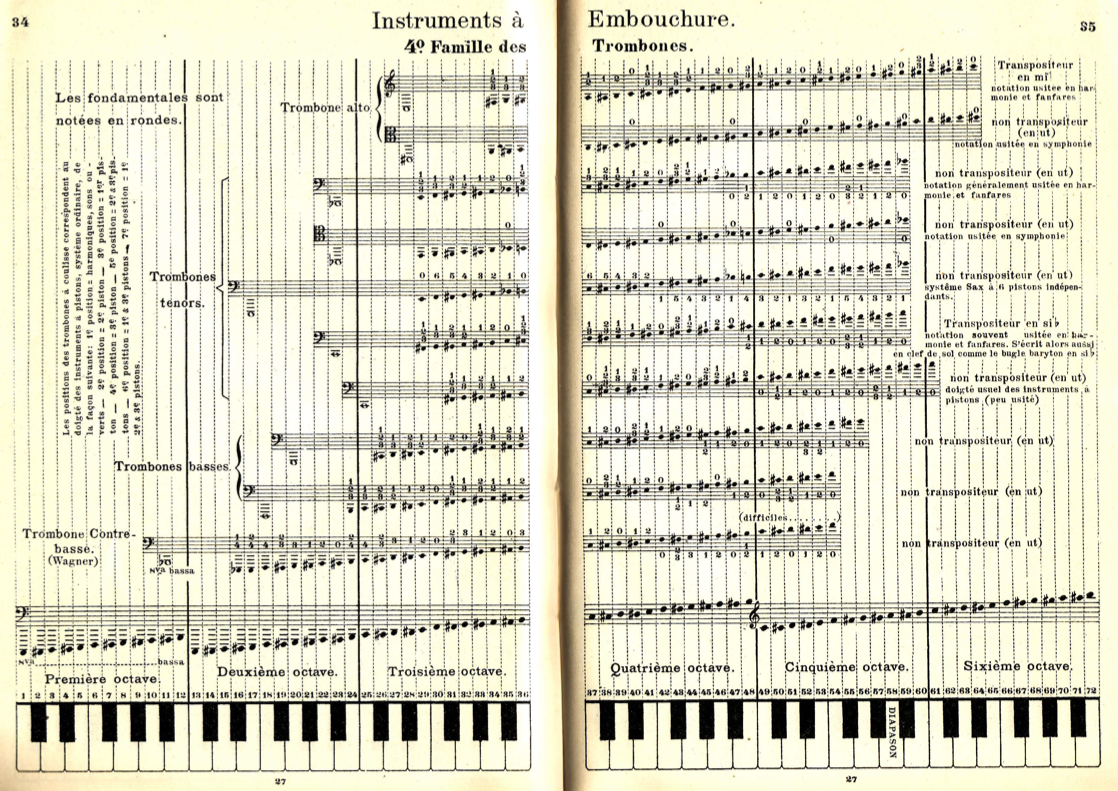
1897—London, England: Charles Vincent, whose Scoring for an Orchestra had been originally appeared in The Organist and Choirmaster, says, “There are three trombones in general use in a complete orchestra, viz.: the alto, tenor, and bass, though frequently the alto instrument is omitted, an additional tenor taking its place (Vincent 30). Regarding the key and range of the alto trombone, he says, “The alto trombone is in E-flat, and has a compass, for practical purposes, from [notated c to d-flat”]” (Vincent 31). And finally, he includes a position chart for alto trombone, saying, “The following are the notes produced from the seven positions on the alto trombone in E-flat [position chart for E-flat alto trombone] (Vincent 32).
1897—Chicago, Illinois: The popular and widely-distributed Sears & Roebuck catalogue includes offerings of 3 different types of alto trombone: one slide alto (according to the catalogue description, an instrument “by the leading French manufacturer”) and two valve altos (one of them “furnished with German silver mouthpiece, German piston valves, water key and music rack,” the other a very compact instrument with “French Light Action silver piston valves” and “German silver mouthpiece”). All three are advertised as instruments in the key of E-flat (see below 3 images; public domain) (Sears 1897, 530). The Sears & Roebuck catalogue continues to offer an E-flat alto in subsequent years (see 1900, below).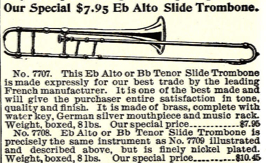
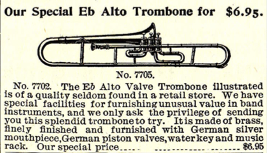
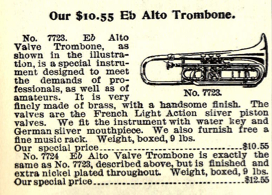
 1897—London, England: Ebenezer Prout writes about alto trombone in his treatise, The Orchestra. His discussion is similar to his text, Instrumentation, from 20 years earlier, the main difference being his inclusion of Italy with France as places where alto is not in use. “Though the tenor trombone, of which we have been speaking, is the only one to be found in the orchestras of France and Italy, two other varieties are employed in this country and in Germany. These are the alto and the bass trombone. Except in pitch, they exactly resemble the tenor trombone, and will therefore need no lengthened description. The ALTO TROMBONE is a perfect fourth higher than the tenor, its fundamental note, with the slide closed, being E flat. The pedal notes of this instrument have never, so far as we know, been employed. Its tone, though somewhat less powerful than that of the tenor trombone, is also brighter, especially in its upper notes. Its compass is from [A] to [E flat] [notates on staves] with all the intermediate semitones; but its lower notes are of inferior quality, and are, besides, not needed, as they lie in the medium of the tenor trombone. Its upper notes, on the other hand, are far superior to the same notes on the tenor, and it is to be regretted that the instrument is not always to be found in our orchestras” (Prout, Orchestra 223-4). He later reiterates regional differences: “In the enormous majority of cases three trombones are employed in the orchestra. In France and Italy, as mentioned above, these are three tenor trombones, in England and Germany, either alto, tenor, and bass or two tenors and bass.” (Prout, Orchestra 225). Finally, he comments on notation: “There is no instrument in the orchestra as to which there is so much diversity of practice, as regards notation, as the trombone. In one respect it differs from all the brass instruments hitherto treated; it is always written at its real pitch, as a non-transposing instrument. The older masters mostly gave a separate staff to each trombone, using the alto, tenor, and bass clefs (Mozart: ‘Don Giovanni,’ second finale; Beethoven: Finale of symphony in C minor, Mass in D, &c.). In modern scores two staves are more frequently employed, the alto and tenor trombones being written on the one and the bass trombone on the other. Either the alto or tenor clef is used for the two upper trombones, the former being the more common, probably because fewer leger [sic] lines are required if the part for the alto trombone lies high. If there are two tenor trombones, instead of an alto and a tenor, the tenor clef is of course adopted. Examples of this will be seen in Wagner’s later scores, though he sometimes, when the parts lie low, writes all the trombones in the F clef (e.g. in the Prelude to ‘Tristan und Isolde’)” (Prout, Orchestra 225).
1897—London, England: Ebenezer Prout writes about alto trombone in his treatise, The Orchestra. His discussion is similar to his text, Instrumentation, from 20 years earlier, the main difference being his inclusion of Italy with France as places where alto is not in use. “Though the tenor trombone, of which we have been speaking, is the only one to be found in the orchestras of France and Italy, two other varieties are employed in this country and in Germany. These are the alto and the bass trombone. Except in pitch, they exactly resemble the tenor trombone, and will therefore need no lengthened description. The ALTO TROMBONE is a perfect fourth higher than the tenor, its fundamental note, with the slide closed, being E flat. The pedal notes of this instrument have never, so far as we know, been employed. Its tone, though somewhat less powerful than that of the tenor trombone, is also brighter, especially in its upper notes. Its compass is from [A] to [E flat] [notates on staves] with all the intermediate semitones; but its lower notes are of inferior quality, and are, besides, not needed, as they lie in the medium of the tenor trombone. Its upper notes, on the other hand, are far superior to the same notes on the tenor, and it is to be regretted that the instrument is not always to be found in our orchestras” (Prout, Orchestra 223-4). He later reiterates regional differences: “In the enormous majority of cases three trombones are employed in the orchestra. In France and Italy, as mentioned above, these are three tenor trombones, in England and Germany, either alto, tenor, and bass or two tenors and bass.” (Prout, Orchestra 225). Finally, he comments on notation: “There is no instrument in the orchestra as to which there is so much diversity of practice, as regards notation, as the trombone. In one respect it differs from all the brass instruments hitherto treated; it is always written at its real pitch, as a non-transposing instrument. The older masters mostly gave a separate staff to each trombone, using the alto, tenor, and bass clefs (Mozart: ‘Don Giovanni,’ second finale; Beethoven: Finale of symphony in C minor, Mass in D, &c.). In modern scores two staves are more frequently employed, the alto and tenor trombones being written on the one and the bass trombone on the other. Either the alto or tenor clef is used for the two upper trombones, the former being the more common, probably because fewer leger [sic] lines are required if the part for the alto trombone lies high. If there are two tenor trombones, instead of an alto and a tenor, the tenor clef is of course adopted. Examples of this will be seen in Wagner’s later scores, though he sometimes, when the parts lie low, writes all the trombones in the F clef (e.g. in the Prelude to ‘Tristan und Isolde’)” (Prout, Orchestra 225).
1897—Frankfurt, Germany: Adolph Pochhammer, writing in his Einführung in die Musik, states that the alto trombone is pitched a fourth above the tenor trombone and the bass trombone is pitched a fourth below tenor trombone. With the tenor trombone presumably in B-flat, this places the other instruments in E-flat (alto) and F (bass). Pochhammer also explains that each instrument is written for in its corresponding clef (Pochhammer 168).
1898—Milan, Italy: Amintore Galli, professor at the Milan Conservatory, writes his orchestration text, Strumenti e Strumentazione, in which he describes an alto trombone in E-flat (trombone contralto), explaining that the instrument is comparable mechanically to the tenor trombone, and showing the instrument’s pitch range (see below image; public domain). He also comments, “In the orchestra, three trombones are used in chorus, in full harmony and sometimes majestic drawn melodies, especially the alto trombone and tenor trombone” (Galli 107-108).![]()
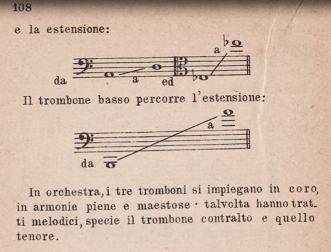
1898—London, England: According to Mansfield, “At the funeral of that great English statesman, the Right Honourable William Ewart Gladstone, in Westminster Abbey, May 28, 1898, there were performed (we believe for the first time in England) Beethoven’s three Equali for four trombone, the trombones and drums uniting with the organ at various points during the service. The four trombone players—two altos, a tenor and a bass—were stationed in the chantry of Henry V, above the high altar. Says a writer who was present, ‘The hushed stillness which pervaded the noble fane was broken with indescribable tenderness as the sustained chord of D minor fell upon the ears of the great congregation in tones of weird simplicity and exquisite pathos.’” Mansfield mentions a specific trombone ensemble: “Their use at Mr. Gladstone’s funeral was due to the action of Mr. George Case, the alto of the London Trombone Quartet, by whom they were played on that occasion” (Mansfield).
1899—Madrid, Spain: Luisa Lacál, discussing the trombone family in her lexicon, Diccionario de la música, téchico, histórico, bio-bibliográfico, states that the alto trombone (trombone contralto or alt-posaune) is pitched in E-flat (Lacál 549).
1899—Tilburg, Netherlands: Musical instrument manufacturer M.J.H. Kessels offers alto trombones in E-flat and F, both slide and valve, in his catalog (see below 2 images; public domain) (Kessels 1899, 23).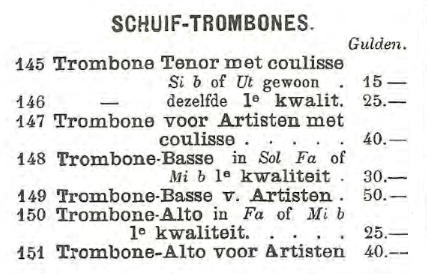
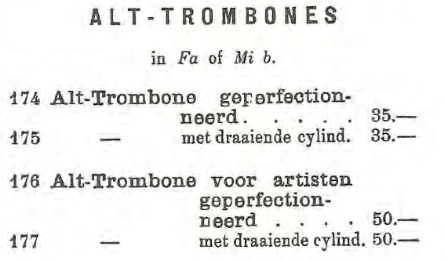
1899—Leipzig, Germany: A catalog of brass instruments for the firm of Julius Heinrich Zimmermann shows a fairly diverse offering of trombones, including alto (in E-flat), tenor, and bass trombones in both valve and slide models (see below image; public domain) (Moeck 106).
1899—Toronto, Canada: William James Henderson says the following in his orchestration text: “The trombone is one of the noblest of all orchestral instruments. When it sounds ignoble, it is either because its part is not well written or because it is badly played. In respect of register there are three principal kinds of trombones—alto, tenor, and bass. The alto has a compass extending from A at the bottom of the bass clef to the E flat in the top space of the treble clef…The alto trombone is in E flat….The tone of the trombone is grave and majestic, but it may be made to rage hoarsely. In all solemn or broadly dignified music trombones play a conspicuous part” (Henderson 34).
Late 1800s—Providence, Rhode Island: Music dealer Georg W. Bailey’s Catalogue of Musical Merchandise offers a Stratton alto trombone, labeled “‘Concerto’ E-flat Alto Trombone,” with options for “Brass,” “Nickel Plated,” and “Triple Silver Plated” (University of California, Santa Barbara Romaine Collection).
c. 1900—New York: Carl Fischer, who later specializes in publishing music, offers an alto valve trombone in his instrument catalog. The instrument is specified as being pitched in E-flat (see below image; public domain).
1900—Chicago, Illinois: The popular and widely-distributed Sears & Roebuck catalogue continues to offer both slide and valve alto trombones among its brass instruments (see also 1897, above). The instruments, clearly listed as pitched in E-flat, are manufactured by French manufacturer Marceau (Sears 1900, 277).
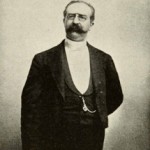 1900—Boston, MA: Louis C. Elson, author of the orchestration chapter of Famous Composers and their Works writes, “The alto, tenor and bass trombones are used frequently in modern music although not regular instruments of the classical orchestra…..the clarinetist often uses the B flat clarinet in defiance of the will of the composer, and many orchestras whose scores call for alto, tenor and bass trombones present all three parts upon tenor, or B flat, trombones….The alto trombone is the smallest of the group and possesses the shortest tube, therefore, the highest tone-series; its deeper register is weak, but the instrument is brilliant and effective in its higher tones; it is called the E flat trombone from the fact that (with closed slides, or without touching its keys) it gives the harmonic series of E flat.” He then provides a position chart for alto trombone in E-flat (Elson, Famous 137).
1900—Boston, MA: Louis C. Elson, author of the orchestration chapter of Famous Composers and their Works writes, “The alto, tenor and bass trombones are used frequently in modern music although not regular instruments of the classical orchestra…..the clarinetist often uses the B flat clarinet in defiance of the will of the composer, and many orchestras whose scores call for alto, tenor and bass trombones present all three parts upon tenor, or B flat, trombones….The alto trombone is the smallest of the group and possesses the shortest tube, therefore, the highest tone-series; its deeper register is weak, but the instrument is brilliant and effective in its higher tones; it is called the E flat trombone from the fact that (with closed slides, or without touching its keys) it gives the harmonic series of E flat.” He then provides a position chart for alto trombone in E-flat (Elson, Famous 137).
1901—Chicago, Illinois: Lyon & Healy, a prominent American manufacturer and distributor of musical instruments, includes numerous alto trombones, all specifically labeled as E-flat instruments, in their New and Enlarged Catalogue of Band Instruments. Shown below are 4 of the altos listed in the catalogue: a slide alto and three valve altos (public domain) (Lyon & Healy 1901, pp. 45, 15, 28, 40).


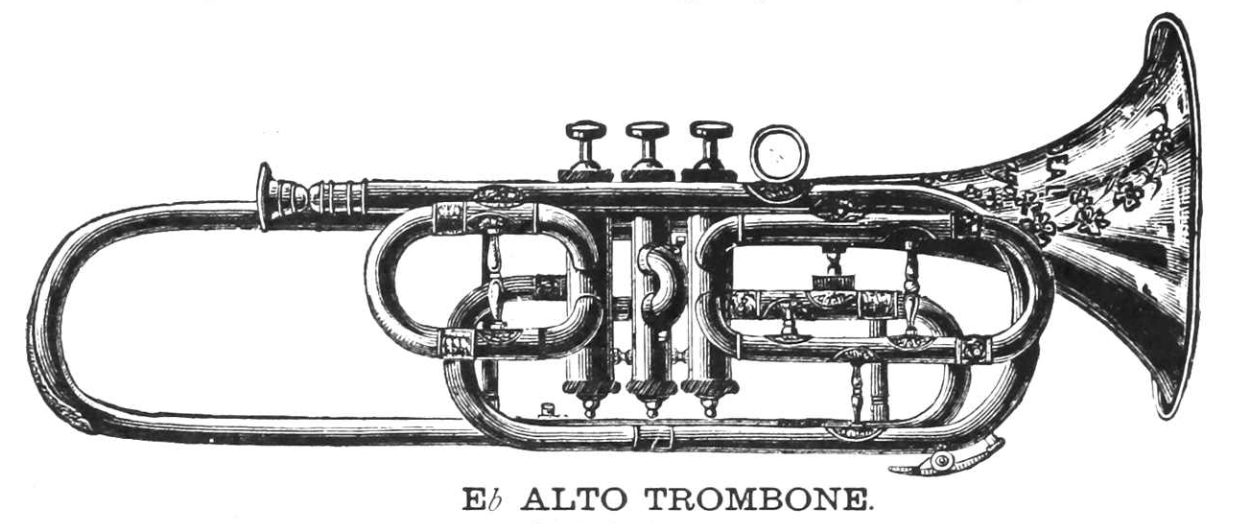
1902—London, England: John Fitzgerald, London conductor and arranger, writes his Modern Instrumentation for String, Military, and Brass Bands, in which he clearly shows ranges for an alto in E-flat, tenor in B-flat, and bass in G (see below image; public domain) (Fitzgerald 35).
1902—London, England: Boosey & Co. offer valve alto trombones in F and E-flat, valve tenors in C and B-flat, and valve basses in A-flat, G, F, and E-flat. By 1923, the only valve trombones they offer are tenors in B-flat and basses in E-flat, F, and G (Baines, Brass 64).
1902—Boston, Massachussetts: An extensive exhibition of musical instruments hosted by Chickering & Sons at Horticulture Hall, Boston, includes at least 3 alto trombones, all pitched in E-flat. One is a slide instrument made by D.C. Hall & Co., Boston (Chickering 36). The other two are rotary valve instruments, one described as “German silver,” the other “Italian” (Chickering 40).
1904—England: J. E. Borland says, “Then we could welcome a more extended use of the contra-trombone also, and a revival of the obsolete soprano and nearly obsolete alto-trombones. Their parts are to-day supplied by other instruments, but complete harmony in one tone-colour produces an effect attainable in no other way” (Borland 476).
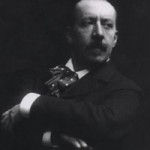 1904—Paris, France: Charles Widor, author of the influential orchestration text, Technique de l’orchestre moderne, comments on the “admirable timbre” of the alto trombone, ranking the instrument as an “indispensable voice” in the traditional quartet of cornetto and 3 trombones: “Despite its admirable timbre, akin to that of the Trumpet in F, the Alto Trombone has now become more or less obsolete, because its compass being much the same, it is almost a duplicate of that magnificent instrument…. It was a characteristic German custom, on Sundays and Church holidays, to have the Choral for the day played by a band of Cornet and Trombone players, standing in the tower of the principal church. Bach introduced this effect into his Cantatas, the brass instrument group playing alone or doubling in unison each of the vocal parts. So, the Cornetto and the Trombones were grouped together, and the Alto became an indispensable voice in this robust quartet” (Widor 78).
1904—Paris, France: Charles Widor, author of the influential orchestration text, Technique de l’orchestre moderne, comments on the “admirable timbre” of the alto trombone, ranking the instrument as an “indispensable voice” in the traditional quartet of cornetto and 3 trombones: “Despite its admirable timbre, akin to that of the Trumpet in F, the Alto Trombone has now become more or less obsolete, because its compass being much the same, it is almost a duplicate of that magnificent instrument…. It was a characteristic German custom, on Sundays and Church holidays, to have the Choral for the day played by a band of Cornet and Trombone players, standing in the tower of the principal church. Bach introduced this effect into his Cantatas, the brass instrument group playing alone or doubling in unison each of the vocal parts. So, the Cornetto and the Trombones were grouped together, and the Alto became an indispensable voice in this robust quartet” (Widor 78).
c. 1904-08—United States: A postcard shows a trombone quartet with several different sizes of trombones (see below image; public domain) (source: TempoSenzaTempo.blogspot.com).
 1905—Boston, Massachussetts: Louis C. Elson, professor of theory at New England Conservatory, publishes Elson’s Music Dictionary. In it, he comments on the valve versus slide trombone, “The trombone with keys is the easier to play, but the slide-trombone has the better tone.” He goes on to talk about pedal tones: “Each instrument [alto, tenor, and bass] can also sound the note an octave deeper than the one given as the lowest in the above schedule. This is however very difficult to do, yet good players can attain this fundamental, by protruding the lips well into the mouthpiece, and can then lower the tone by means of the slides. These deep tones are called the pedal tones and must be sparingly used….The pedal tones have a growling, unpleasant quality” (Elson, Music Dictionary 271).
1905—Boston, Massachussetts: Louis C. Elson, professor of theory at New England Conservatory, publishes Elson’s Music Dictionary. In it, he comments on the valve versus slide trombone, “The trombone with keys is the easier to play, but the slide-trombone has the better tone.” He goes on to talk about pedal tones: “Each instrument [alto, tenor, and bass] can also sound the note an octave deeper than the one given as the lowest in the above schedule. This is however very difficult to do, yet good players can attain this fundamental, by protruding the lips well into the mouthpiece, and can then lower the tone by means of the slides. These deep tones are called the pedal tones and must be sparingly used….The pedal tones have a growling, unpleasant quality” (Elson, Music Dictionary 271).
1905—Paris, France: A “sudrophone trombone” in both E-flat (alto) and B-flat (tenor) is advertised in the catalog of F. Sudre (see below image; public domain).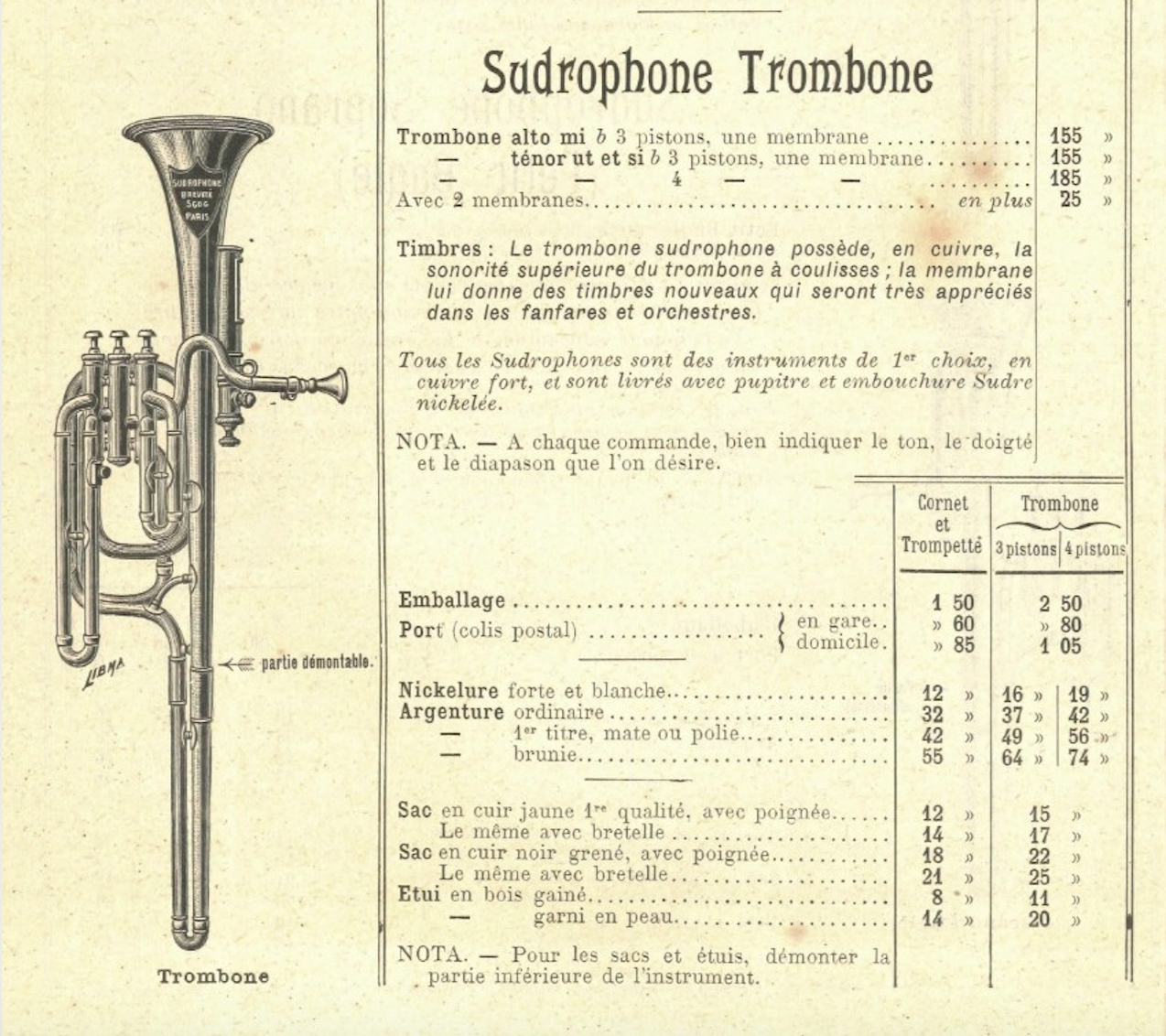
 1906-1929—Widely-recognized British musicologist Donald Tovey writes a series of articles for Encyclopaedia Britannicathat are subsequently collected into the now-classic Forms of Music. Tovey complains,“For lack of the alto trombone many of Beethoven’s top notes must nowadays be lowered; and then our smart young orchestrators blame Beethoven for his ill-balanced chords” (Tovey 81).
1906-1929—Widely-recognized British musicologist Donald Tovey writes a series of articles for Encyclopaedia Britannicathat are subsequently collected into the now-classic Forms of Music. Tovey complains,“For lack of the alto trombone many of Beethoven’s top notes must nowadays be lowered; and then our smart young orchestrators blame Beethoven for his ill-balanced chords” (Tovey 81).
c. 1907—Williamsport, Pennsylvania: Henry Distin’s instrument catalog offers an alto valve trombone, specified as an E-flat instrument (see below image; public domain). 
1908—Ixelles, Belgium: Emile Ergo, Professor of Harmony, Counterpoint, and Instrumentation at the Institute of High Musical Studies, Ixelles, Belgium, authors the treatise, Dans les propylées de l’instrumentation. About the family of trombones and use of clefs he says, “After the traditional rule, each species of trombone uses the clef of the corresponding voice.” He also clearly describes an alto trombone in E-flat, with the label “Trombone-alto (mi flat),” followed by a staff with alto clef and a notated e-flat on the staff. He labels tenor clef “Trombone-ténor (si flat),” followed by a staff with tenor clef and a notated b-flat on the staff (Ergo 38).
1908—London, England: George Case, British trombonist and professor at the Royal College of Music, advocating for the alto trombone, bemoans “the alto-trombone having almost fallen into disuse through the ignorance of the modern conductor as to the proper balance of tone-colour in the orchestra” (Bennett 204).
1908—Chicago, Illinois: The popular and widely-circulated Sears & Roebuck catalogue continues to include alto trombones among its offerings (see also 1897 and 1900, above). Like the alto trombones in previous catalogues, the instruments are all in the key of E-flat. Unlike previous offerings, which included slide alto trombones, only valve instruments are represented (see below 3 images; public domain) (Sears 1908, 249-251).
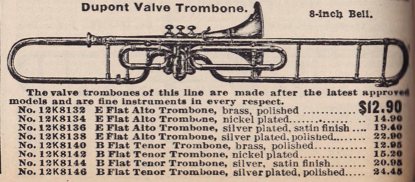

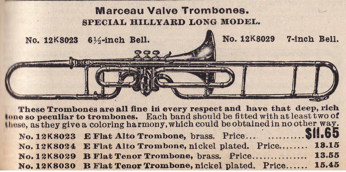
1911—Clappé, in his text, The Wind Band and its Instruments, mentions “Eb alto,” showing its harmonic series in E-flat (Clappé).
1911/13—Arnold Schoenberg, Gurre-Lieder, calls for 7 trombones, including alto and contrabass.
1912—France: The Couesnon catalog offers a valve alto trombone, specified in 2 different places as an E-flat instrument (see below images; public domain).

1912—France: A price list for Thibouville, a French instrument manufacturer and distributor, lists alto trombone as an E-flat instrument, not B-flat or C (see image below; public domain).
1913—Berlin, Germany: Franz Mayerhoff writes his instrumentation text, Instrumentenlehre, in which he shows an alto trombone position chart for an instrument that is clearly in E-flat (see below image; public domain) (Mayerhoff 57).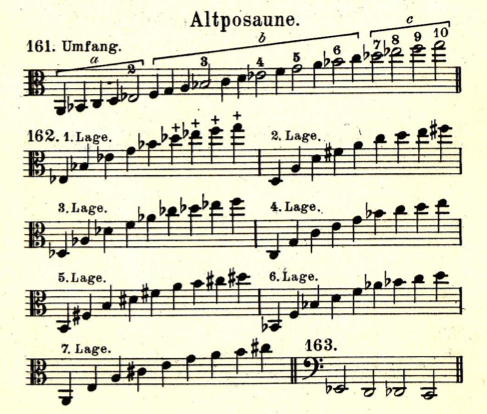
1914—London, England: Cecil Forsyth writes the following about the alto trombone in his orchestration text: “The Alto (or E-flat) Trombone: This Trombone is now practically obsolete. It is built in the key of E-flat, a perfect fourth higher than the Tenor….The part was almost invariably written in the alto-clef, but the bass-clef was used occasionally and conveniently for the lowest notes” (Forsyth 139).
1915—Tilburg, Netherlands: M.J.H. Kessels, one of the largest instrument manufacturers in Europe, offers alto trombones in E-flat and F (see below image from 1915 catalog; public domain).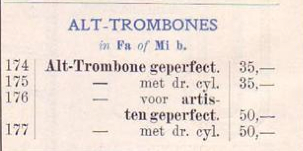
1916—Orlando Mansfield relates the experience of a “Dr. Stone” with an apparently unusual ensemble: “That noted English musical scientist, the late Dr. Stone, relates that being ‘requested to lead the singing in the open air at the laying of the foundation stone of a church’ he used a quartet consisting of a slide trumpet, alto and tenor trombones, with euphonium and contrafagotto in octaves for the positive bass.’ He declares that ‘with good playing’ the result was ‘striking and, perhaps, deserving of imitation’” (Mansfield).
 1917—Horatio Parker, one of the most respected American composers of his time, mentions that using alto trombone rather than tenor results in “a certain transparency, even gracility, in general effect” (Parker 486).
1917—Horatio Parker, one of the most respected American composers of his time, mentions that using alto trombone rather than tenor results in “a certain transparency, even gracility, in general effect” (Parker 486).
1919—Berlin, Germany: Hugo Riemann, influential musicologist and professor at Leipzig University, writes his Handbuch der Musikinstrumente, in which he diagrams the range of the alto trombone, clearly an instrument in E-flat (see below image; public domain) (Riemann Handbuch 87).
1920—Ulric Daubeny, in his book, Orchestral Wind Instruments, comments on the current use of alto trombone and contrabass trombone: “…during recent years the alto has almost entirely dropped out of use, the parts being played on the tenor instrument, while the contrabass is very rarely met with” (Daubeny 97).
 1921—Brussels, Belgium: Belgian composer and teacher Paul Gilson, former Professor of Composition at Brussels Conservatory, writes the following in his treatise, Le Tutti Orchestral: “The alto trombone, which has fallen into disuse, was in E flat–a fourth above tenor trombone in B flat; the latter is the only one that remains of the old trio of trombones. The alto trombone therefore climbed with relative ease up to E flat (see the 4th movement of the 3rd Symphony by Schumann, 4th measure; this passage is cited by Gevaert in his Traite d’Instrumentation)” (Gilson 58).
1921—Brussels, Belgium: Belgian composer and teacher Paul Gilson, former Professor of Composition at Brussels Conservatory, writes the following in his treatise, Le Tutti Orchestral: “The alto trombone, which has fallen into disuse, was in E flat–a fourth above tenor trombone in B flat; the latter is the only one that remains of the old trio of trombones. The alto trombone therefore climbed with relative ease up to E flat (see the 4th movement of the 3rd Symphony by Schumann, 4th measure; this passage is cited by Gevaert in his Traite d’Instrumentation)” (Gilson 58).
1922—Tilburg, Netherlands: M.J.H. Kessels, one of the largest instrument manufacturers in Europe, offers alto trombones in E-flat and F, slide and valve (see below image from 1922 catalog; public domain).
1922—Boston, Massachusetts: Arthur Elson remarks in Orchestra Instruments and Their Use, “The alto trombone stands in F; that is to say, its fundamental tone is F, and its harmonic series with closed slides is based on that note. Its lower register is inferior in quality, and as it corresponds to the best part of the tenor trombone, it is never needed. But its upper notes are superior to the same tones on any other instrument of this family, and they might well be included in some of our extensive modern orchestras” (Elson, Orchestra 240).
1924—Boston, Massachusetts: William C. White discusses the trombone family in his treatise, Military Band Arranging, clearly stating the key of alto trombone: “Trombones are built in E-flat alto…” (White 23).
1926—Paris, France: Courtois pictures, in its catalog, 4 different trombones: trombone alto in e-flat, trombone tenor “Modele Conservatoire,” trombone tenor and bass “Modele Conservatoire,” and trombone contrabass (see below image; public domain).
1926—Edwin Evans includes a very thorough discussion of the trombone family in his Method of Instrumentation. About bass and alto trombones he says, “There are (or rather used to be) three trombones in use–the alto, tenor and bass. Of the latter there were also formerly three types; but now, for practical purposes, the bass trombone in G may be taken as understood, where nothing contrary is expressed. In the same way, the alto may be taken as in E flat; although, formerly, there also existed another type in F” (Evans 76). He also includes position charts for all 3 sizes (alto, tenor, bass) that clearly show alto in E-flat (Evans 77, 79), also referring to alto trombone in E-flat while discussing pedal tones (Evans 81). Finally, he expresses his opinion that using 3 tenors instead of alto, tenor, and bass degrades the trombone and results in unfortunate orchestration, such as doubling bass lines: “It may be admitted that, generally speaking, the tenor trombone is the best type of instrument; but the unfortunate result is that all players affect it to the exclusion of the others. Its use is so prevalent that it has become unsafe to write even for the bass trombone, as there is no certainty of its being present; though, should the trombone parts be important in a composition, the change from the mixed trio to three tenor trombones would be very noticeable. The outcome of it all is to degrade the instrument; for, while composers are uncertain how their trombone parts are to be treated, they naturally arrange matters to suit any event, and accordingly we find the trombones doubling the bass and having other servile work instead of having pure and independent parts of their own” (Evans 81).
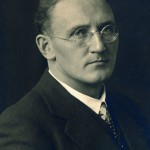 1933—Herman Scherchen, the distinguished German conductor, says in his Handbook of Conducting, “The alto trombone: Every orchestra should possess one of these; it is, even nowadays, indispensable for performing Mendelssohn’s ‘Ruy Blas’ Overture; Schumann’s E flat major Symphony; ‘Rienzi’; ‘La Muette de Portici’; and Bach’s ‘Art of Fugue’ in Wolfgang Gräser’s arrangement” (Scherchen 102).
1933—Herman Scherchen, the distinguished German conductor, says in his Handbook of Conducting, “The alto trombone: Every orchestra should possess one of these; it is, even nowadays, indispensable for performing Mendelssohn’s ‘Ruy Blas’ Overture; Schumann’s E flat major Symphony; ‘Rienzi’; ‘La Muette de Portici’; and Bach’s ‘Art of Fugue’ in Wolfgang Gräser’s arrangement” (Scherchen 102).
1938—Germany: Wunderlich’s catalog includes 3 alto trombones, all listed as either F or E-flat instruments (see below 2 images; public domain).
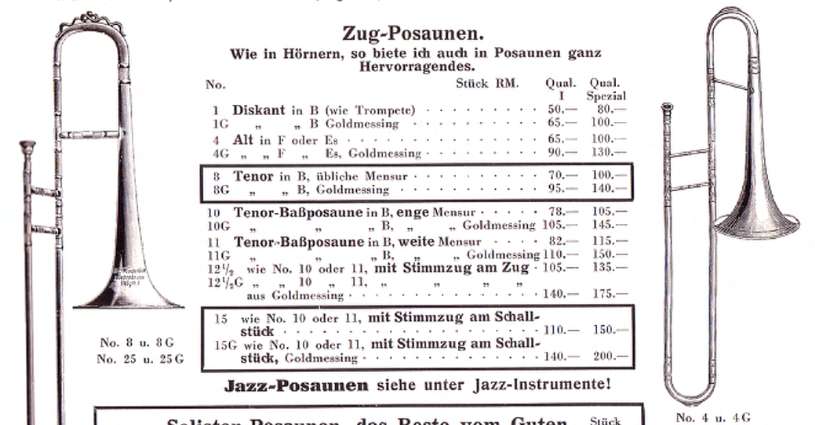
1941—Nicholas Bessaraboff, writing about European musical instruments for the Museum of Fine Arts in Boston, remarks on alto trombone: “The alto trombone has a small but distinctive voice of its own, and if the instrument were to be experimented with as much as the modern tenor trombone, no doubt fine alto trombones could be built. Its disappearance from the orchestra was mainly due to the fact that when valves were applied to the trumpet, there were two trumpets, in F and in E-flat, which could substitute for it. In some orchestras the alto trombone parts were played on these trumpets. After both the alto trombone and the low-pitched valve trumpets disappeared from the orchestra, the first tenor trombone player was required to play the alto trombone parts. The composers wrote higher and higher for brass instruments, a tendency deplored by Widor. This had one unpleasant consequence: trombonists began to ask for instruments which would produce the tones of the upper register with greater ease. This meant a smaller bore and smaller bell, a development which eventually resulted in the ‘pea shooter,’ a miserably sounding effeminate caricature” (Bessaraboff 189).
 1959—In the context of a discussion about instrumentation, Igor Stravinsky specifically mentions alto trombone among those instruments he is fond of: “What instruments do I like? I wish there were more good players for the bass clarinet and the contra-bass clarinet, for the alto trombone (of my Threni and Berg’s Altenberg Lieder), for the guitar, the mandoline and the cymbalom. Do I dislike any instrument? Well, I am not very fond of the two most conspicuous instruments of the Lulu orchestra, the vibraphone and the alto saxophone” (Stravinsky and Craft 30).
1959—In the context of a discussion about instrumentation, Igor Stravinsky specifically mentions alto trombone among those instruments he is fond of: “What instruments do I like? I wish there were more good players for the bass clarinet and the contra-bass clarinet, for the alto trombone (of my Threni and Berg’s Altenberg Lieder), for the guitar, the mandoline and the cymbalom. Do I dislike any instrument? Well, I am not very fond of the two most conspicuous instruments of the Lulu orchestra, the vibraphone and the alto saxophone” (Stravinsky and Craft 30).
1960s and 70s—Classical music’s historical movement, as well as discovery of several important alto trombone solos (including Wagenseil Concerto, Michael Haydn Larghetto and Divertimento in D, and Albrechtsberger Concerto), leads to resurgence of alto trombone.
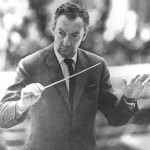 1966—Benjamin Britten, after lengthy correspondence with a trombone player, writes cross-harmonic lip glissandos in alto trombone and horn parts in The Burning Fiery Furnace (Wills, Frontiers 258).
1966—Benjamin Britten, after lengthy correspondence with a trombone player, writes cross-harmonic lip glissandos in alto trombone and horn parts in The Burning Fiery Furnace (Wills, Frontiers 258).
1968—New York: In a rehearsal of Beethoven’s Leonore Overture No. 3 with the American Symphony, Leopold Stokowski says the following to the principal trombonist: “Do you have an alto trombone? Do you have one? Could we use it in this? I think it has another quality of tone. Alright?” (YouTube excerpt of rehearsal filmed in 1968 at Madison Square Gardens concert hall; the excerpt is later used in a 1970 documentary titled, “Stokowski at 88”). Special thanks to Joost Geevers, Conservatory of The Hague.
1980—Alfred Blatter, who later becomes an orchestration instructor at the prestigious Curtis Institute of Music, mentions an alto trombone “comeback” in his orchestration textbook: “Once given up for lost, the alto trombone is making a modest comeback. This rise in popularity has been due to a renewed interest in older music written specifically for the alto trombone, to the interest shown by some contemporary composers in its lighter, sweeter sound, and to the relative ease it offers in the performance of some of the high nineteenth-century orchestral parts” (Blatter 163).
 1982—Samuel Adler, in The Study of Orchestration, says, “The alto trombone was used extensively throughout the nineteenth century, especially by German and Italian composers. It was also a solo instrument during the eighteenth century. Toward the end of the nineteenth century, most composers settled on two tenors and one bass, and the alto fell into disuse. However, many first trombonists today are once again using this instrument to play especially high tessitura parts and to perform the parts originally written for it” (Adler 288).
1982—Samuel Adler, in The Study of Orchestration, says, “The alto trombone was used extensively throughout the nineteenth century, especially by German and Italian composers. It was also a solo instrument during the eighteenth century. Toward the end of the nineteenth century, most composers settled on two tenors and one bass, and the alto fell into disuse. However, many first trombonists today are once again using this instrument to play especially high tessitura parts and to perform the parts originally written for it” (Adler 288).
1984—Frigyes Hidas, Baroque Concerto for Alto Trombone and String Orchestra.
1984—Don Appert, Maskil for Alto Trombone and Piano.
1986—Thom Ritter George, Sonata for Alto Trombone and Piano.
 1992—London, England: Norman Del Mar, the respected British conductor, Romantic era specialist, longtime conducting professor at Royal College of Music, and former horn player in the Royal Philharmonic Orchestra, comments on the trombone’s high F in Beethoven’s Symphony No. 5: “Now, although this very high note can certainly be reached today by good principal trombonists on the tenor instrument, the return of the once obsolete alto trombone is much to be welcomed, giving not only greater assurance at this extreme upper register but also a fine quality of sound” (Del Mar, Conducting Beethoven 96).
1992—London, England: Norman Del Mar, the respected British conductor, Romantic era specialist, longtime conducting professor at Royal College of Music, and former horn player in the Royal Philharmonic Orchestra, comments on the trombone’s high F in Beethoven’s Symphony No. 5: “Now, although this very high note can certainly be reached today by good principal trombonists on the tenor instrument, the return of the once obsolete alto trombone is much to be welcomed, giving not only greater assurance at this extreme upper register but also a fine quality of sound” (Del Mar, Conducting Beethoven 96).
1993—Merton Shatzkin, in his orchestration text, says the following about alto trombone: “The instrument may be making a comeback, since more players seem to be using it” (Shatzkin 90).
1994—John Kenny, Sonata for Alto Trombone.
1994—Elizabeth Raum, “Olmütz” Concerto for Alto Trombone and Orchestra.
1995—Walter Hartley, Fantasia on Vermont Tunes (alto trombone).
2005—Roland John Jackson, expert on performance practice and longtime editor of the Performance Practice Review, mentions the color and sonority contributed by alto trombone: “As the [nineteenth] century wore on the alto began to drop away and the tenor and bass became fused into a single instrument. This, however, robbed the trombone section of something of its distinctive color and sonority; the absence of an alto trombone, for instance, takes away from the effectiveness of the entrance of the three trombones in the finale of Beethoven’s Fifth Symphony” (Jackson 410).
